University Student Nutrition and Physical Activity Assessment Report
VerifiedAdded on 2023/04/21
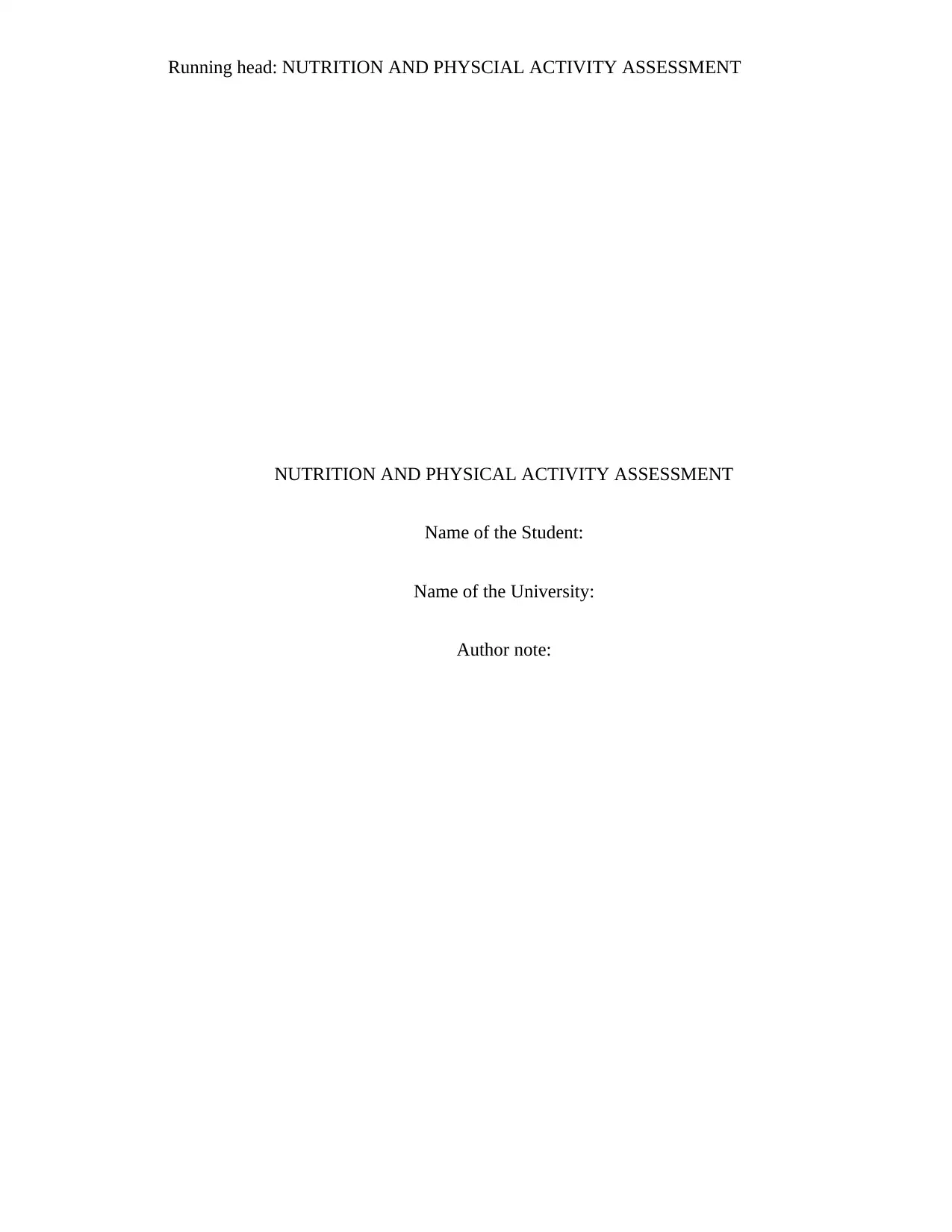
NUTRITION AND PHYSICAL ACTIVITY ASSESSMENT
Name of the Student:
Name of the University:
Author note:
Paraphrase This Document
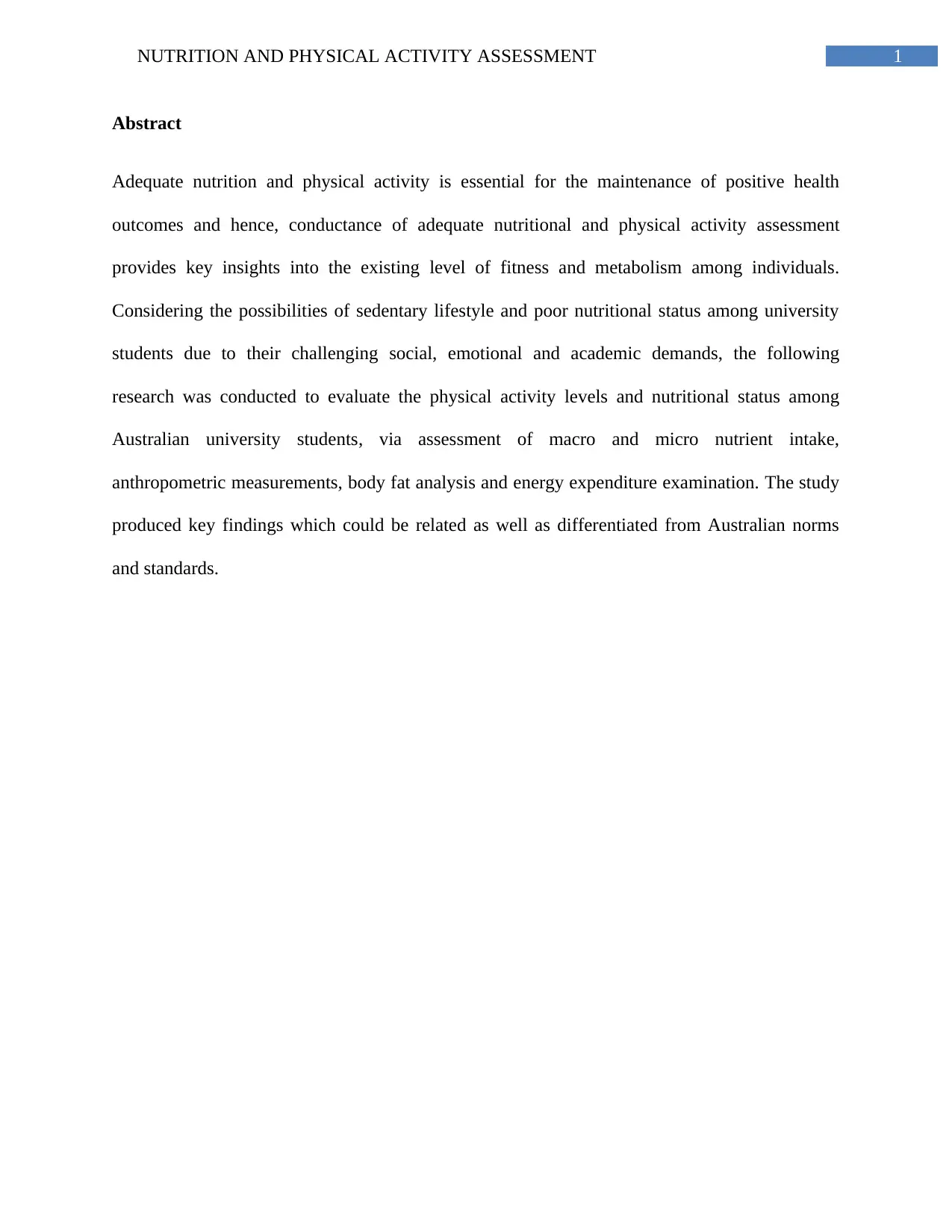
Abstract
Adequate nutrition and physical activity is essential for the maintenance of positive health
outcomes and hence, conductance of adequate nutritional and physical activity assessment
provides key insights into the existing level of fitness and metabolism among individuals.
Considering the possibilities of sedentary lifestyle and poor nutritional status among university
students due to their challenging social, emotional and academic demands, the following
research was conducted to evaluate the physical activity levels and nutritional status among
Australian university students, via assessment of macro and micro nutrient intake,
anthropometric measurements, body fat analysis and energy expenditure examination. The study
produced key findings which could be related as well as differentiated from Australian norms
and standards.
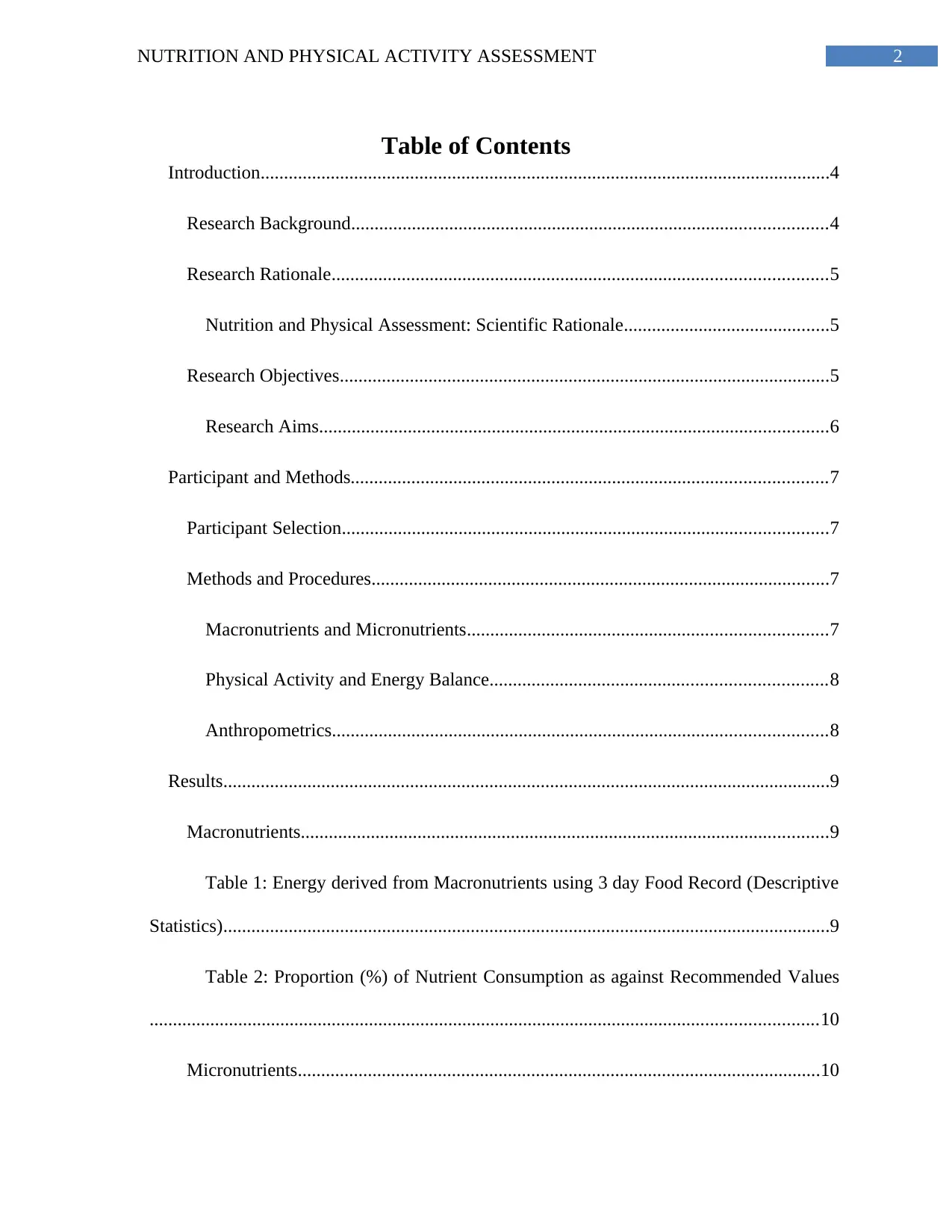
Table of Contents
Introduction..........................................................................................................................4
Research Background......................................................................................................4
Research Rationale..........................................................................................................5
Nutrition and Physical Assessment: Scientific Rationale............................................5
Research Objectives.........................................................................................................5
Research Aims.............................................................................................................6
Participant and Methods......................................................................................................7
Participant Selection........................................................................................................7
Methods and Procedures..................................................................................................7
Macronutrients and Micronutrients.............................................................................7
Physical Activity and Energy Balance........................................................................8
Anthropometrics..........................................................................................................8
Results..................................................................................................................................9
Macronutrients.................................................................................................................9
Table 1: Energy derived from Macronutrients using 3 day Food Record (Descriptive
Statistics)..................................................................................................................................9
Table 2: Proportion (%) of Nutrient Consumption as against Recommended Values
...............................................................................................................................................10
Micronutrients................................................................................................................10
⊘ This is a preview!⊘
Do you want full access?
Subscribe today to unlock all pages.

Trusted by 1+ million students worldwide
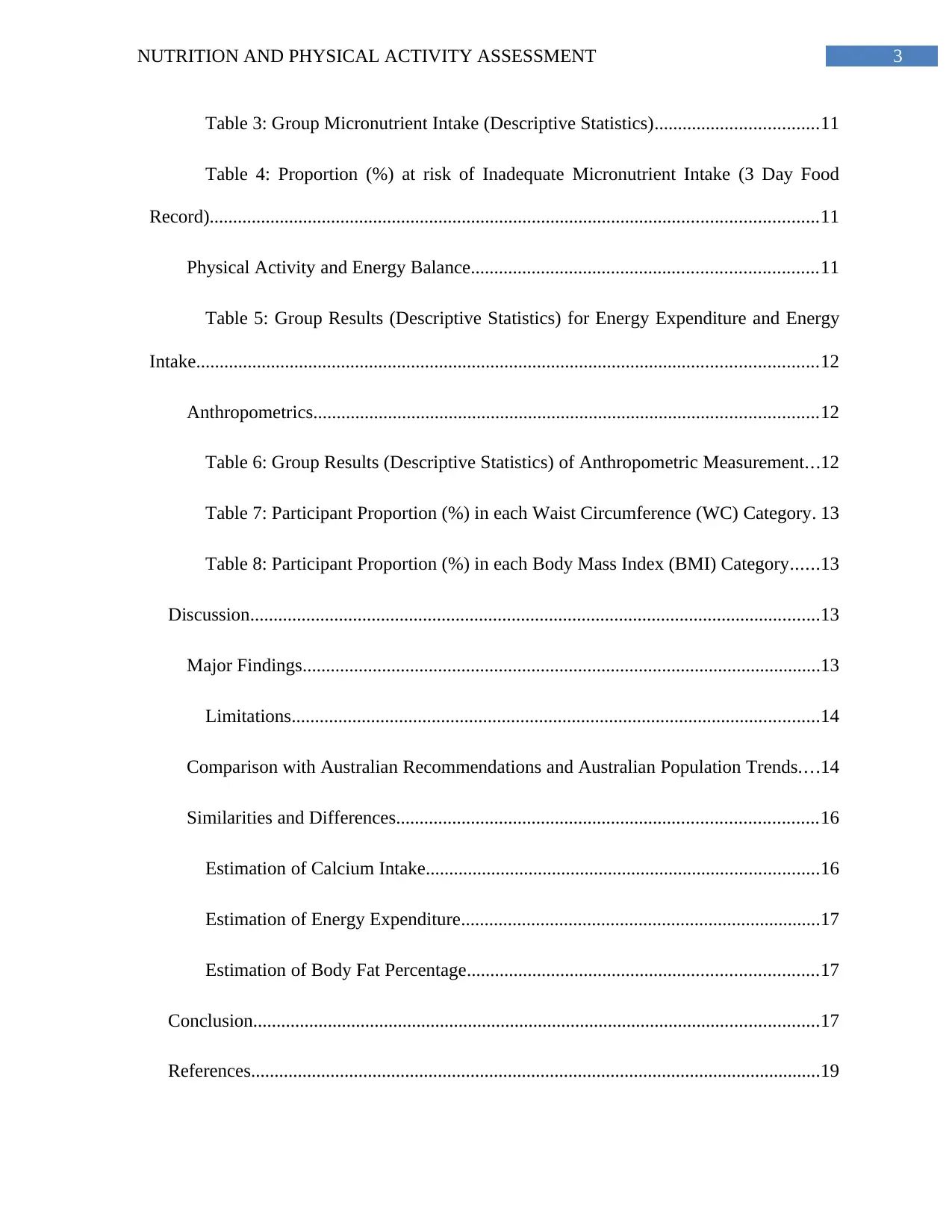
Table 3: Group Micronutrient Intake (Descriptive Statistics)...................................11
Table 4: Proportion (%) at risk of Inadequate Micronutrient Intake (3 Day Food
Record)..................................................................................................................................11
Physical Activity and Energy Balance..........................................................................11
Table 5: Group Results (Descriptive Statistics) for Energy Expenditure and Energy
Intake.....................................................................................................................................12
Anthropometrics............................................................................................................12
Table 6: Group Results (Descriptive Statistics) of Anthropometric Measurement...12
Table 7: Participant Proportion (%) in each Waist Circumference (WC) Category. 13
Table 8: Participant Proportion (%) in each Body Mass Index (BMI) Category......13
Discussion..........................................................................................................................13
Major Findings...............................................................................................................13
Limitations.................................................................................................................14
Comparison with Australian Recommendations and Australian Population Trends....14
Similarities and Differences..........................................................................................16
Estimation of Calcium Intake....................................................................................16
Estimation of Energy Expenditure.............................................................................17
Estimation of Body Fat Percentage...........................................................................17
Conclusion.........................................................................................................................17
References..........................................................................................................................19
Paraphrase This Document
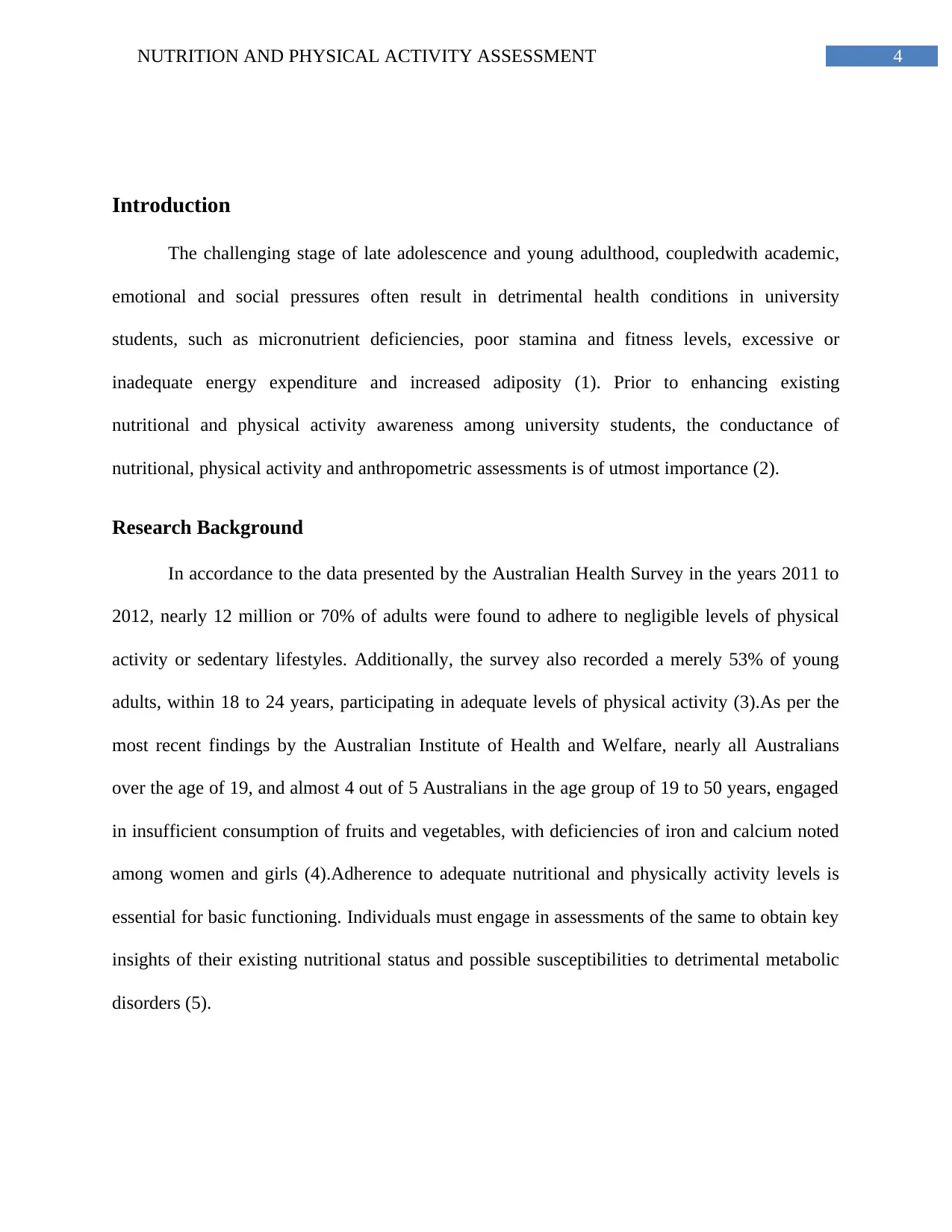
Introduction
The challenging stage of late adolescence and young adulthood, coupledwith academic,
emotional and social pressures often result in detrimental health conditions in university
students, such as micronutrient deficiencies, poor stamina and fitness levels, excessive or
inadequate energy expenditure and increased adiposity (1). Prior to enhancing existing
nutritional and physical activity awareness among university students, the conductance of
nutritional, physical activity and anthropometric assessments is of utmost importance (2).
Research Background
In accordance to the data presented by the Australian Health Survey in the years 2011 to
2012, nearly 12 million or 70% of adults were found to adhere to negligible levels of physical
activity or sedentary lifestyles. Additionally, the survey also recorded a merely 53% of young
adults, within 18 to 24 years, participating in adequate levels of physical activity (3).As per the
most recent findings by the Australian Institute of Health and Welfare, nearly all Australians
over the age of 19, and almost 4 out of 5 Australians in the age group of 19 to 50 years, engaged
in insufficient consumption of fruits and vegetables, with deficiencies of iron and calcium noted
among women and girls (4).Adherence to adequate nutritional and physically activity levels is
essential for basic functioning. Individuals must engage in assessments of the same to obtain key
insights of their existing nutritional status and possible susceptibilities to detrimental metabolic
disorders (5).
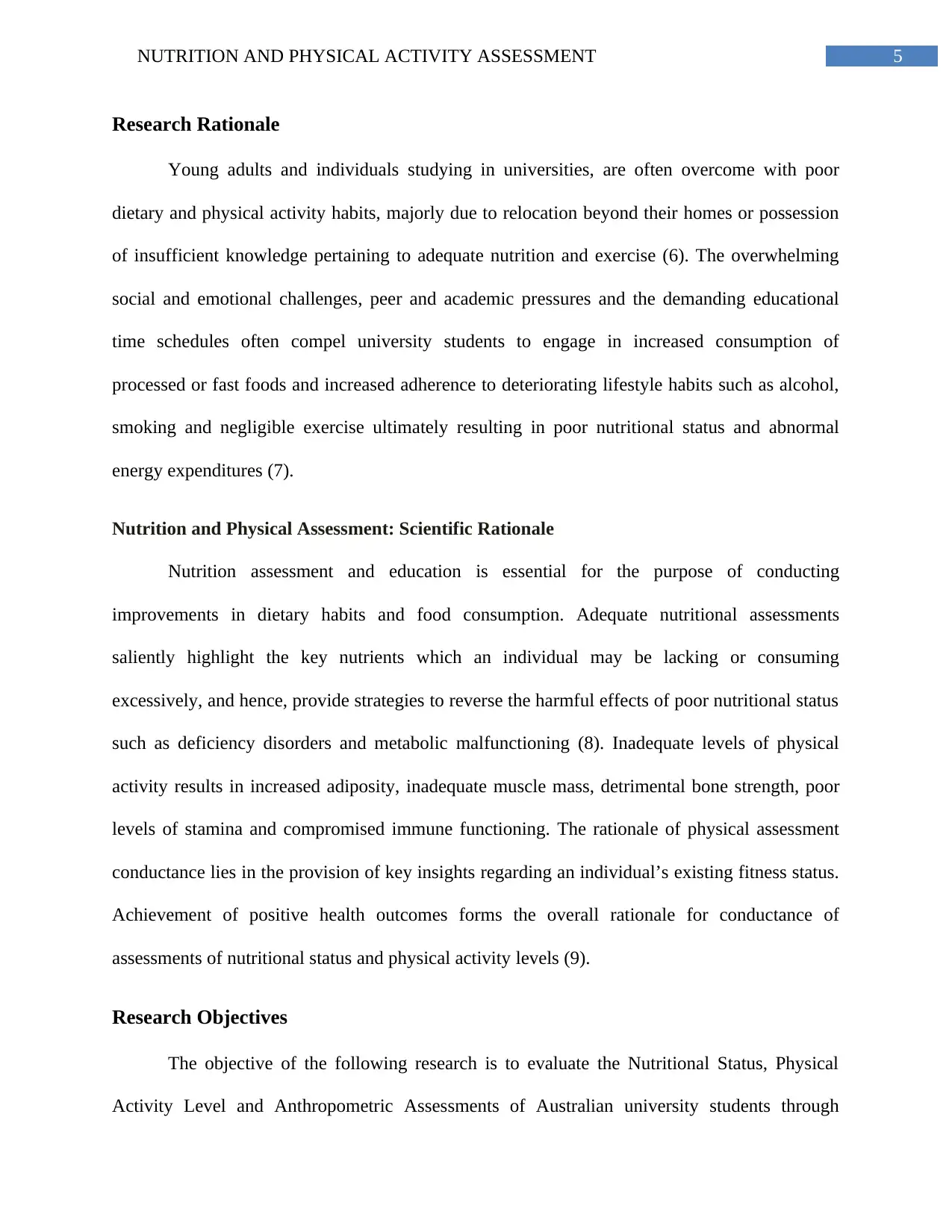
Research Rationale
Young adults and individuals studying in universities, are often overcome with poor
dietary and physical activity habits, majorly due to relocation beyond their homes or possession
of insufficient knowledge pertaining to adequate nutrition and exercise (6). The overwhelming
social and emotional challenges, peer and academic pressures and the demanding educational
time schedules often compel university students to engage in increased consumption of
processed or fast foods and increased adherence to deteriorating lifestyle habits such as alcohol,
smoking and negligible exercise ultimately resulting in poor nutritional status and abnormal
energy expenditures (7).
Nutrition and Physical Assessment: Scientific Rationale
Nutrition assessment and education is essential for the purpose of conducting
improvements in dietary habits and food consumption. Adequate nutritional assessments
saliently highlight the key nutrients which an individual may be lacking or consuming
excessively, and hence, provide strategies to reverse the harmful effects of poor nutritional status
such as deficiency disorders and metabolic malfunctioning (8). Inadequate levels of physical
activity results in increased adiposity, inadequate muscle mass, detrimental bone strength, poor
levels of stamina and compromised immune functioning. The rationale of physical assessment
conductance lies in the provision of key insights regarding an individual’s existing fitness status.
Achievement of positive health outcomes forms the overall rationale for conductance of
assessments of nutritional status and physical activity levels (9).
Research Objectives
The objective of the following research is to evaluate the Nutritional Status, Physical
Activity Level and Anthropometric Assessments of Australian university students through
⊘ This is a preview!⊘
Do you want full access?
Subscribe today to unlock all pages.

Trusted by 1+ million students worldwide
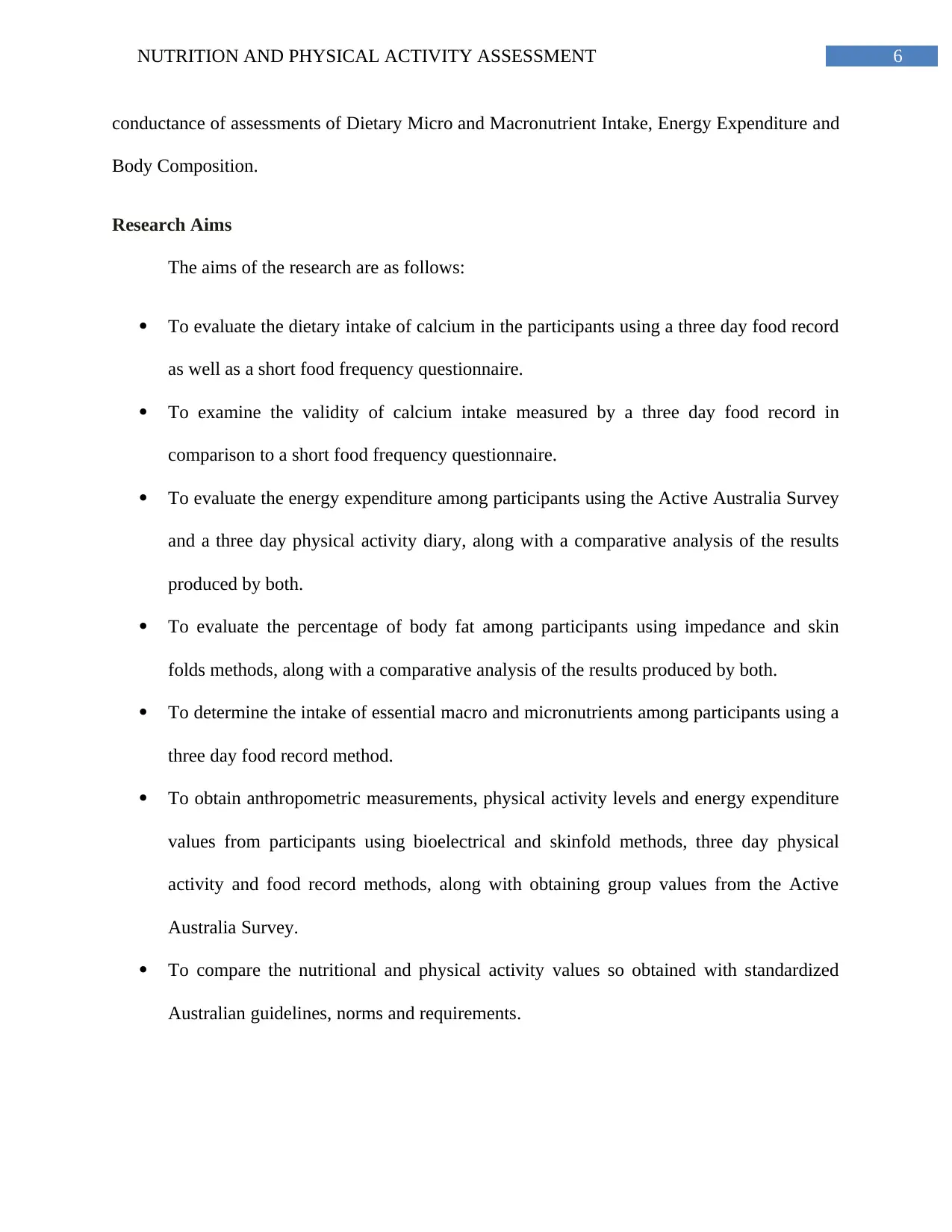
conductance of assessments of Dietary Micro and Macronutrient Intake, Energy Expenditure and
Body Composition.
Research Aims
The aims of the research are as follows:
To evaluate the dietary intake of calcium in the participants using a three day food record
as well as a short food frequency questionnaire.
To examine the validity of calcium intake measured by a three day food record in
comparison to a short food frequency questionnaire.
To evaluate the energy expenditure among participants using the Active Australia Survey
and a three day physical activity diary, along with a comparative analysis of the results
produced by both.
To evaluate the percentage of body fat among participants using impedance and skin
folds methods, along with a comparative analysis of the results produced by both.
To determine the intake of essential macro and micronutrients among participants using a
three day food record method.
To obtain anthropometric measurements, physical activity levels and energy expenditure
values from participants using bioelectrical and skinfold methods, three day physical
activity and food record methods, along with obtaining group values from the Active
Australia Survey.
To compare the nutritional and physical activity values so obtained with standardized
Australian guidelines, norms and requirements.
Paraphrase This Document
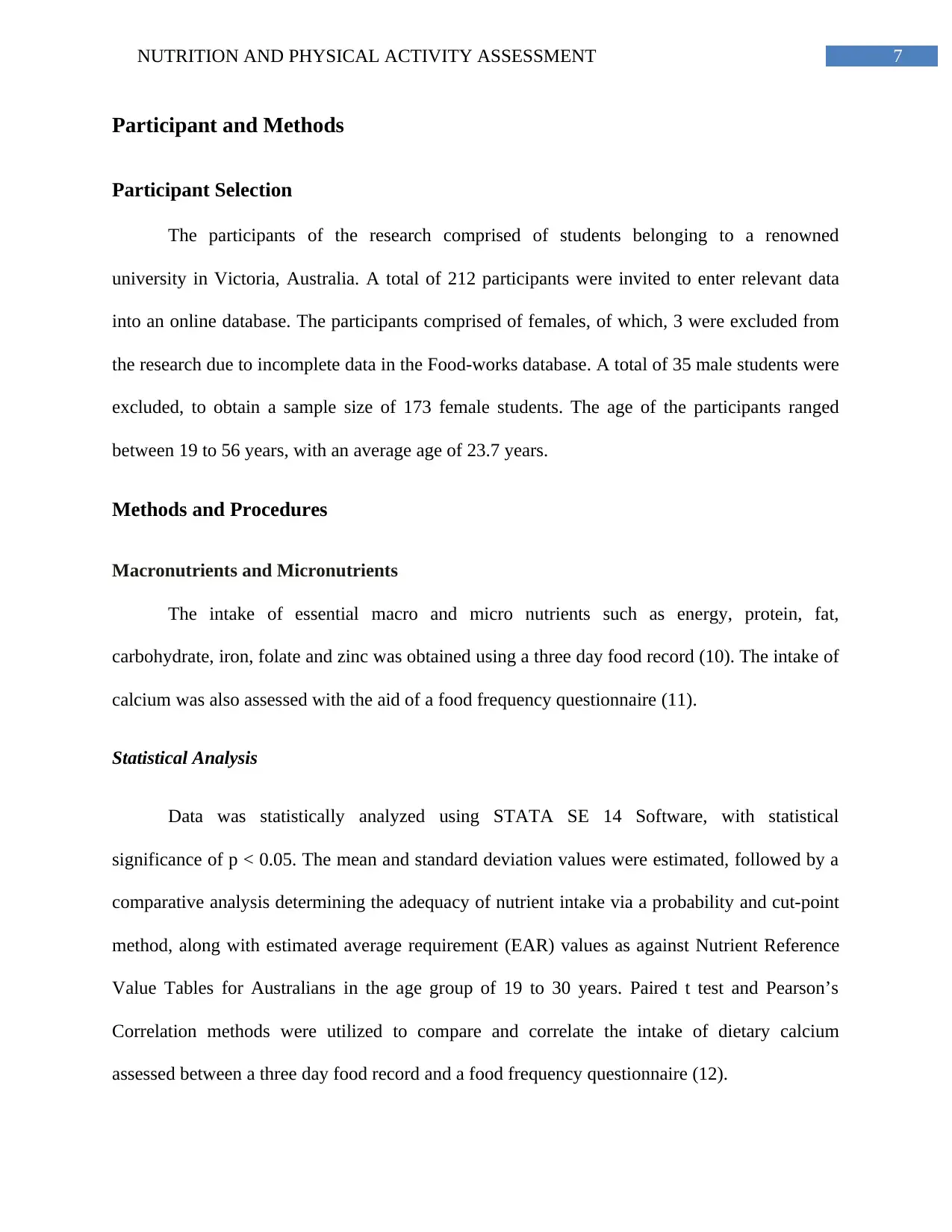
Participant and Methods
Participant Selection
The participants of the research comprised of students belonging to a renowned
university in Victoria, Australia. A total of 212 participants were invited to enter relevant data
into an online database. The participants comprised of females, of which, 3 were excluded from
the research due to incomplete data in the Food-works database. A total of 35 male students were
excluded, to obtain a sample size of 173 female students. The age of the participants ranged
between 19 to 56 years, with an average age of 23.7 years.
Methods and Procedures
Macronutrients and Micronutrients
The intake of essential macro and micro nutrients such as energy, protein, fat,
carbohydrate, iron, folate and zinc was obtained using a three day food record (10). The intake of
calcium was also assessed with the aid of a food frequency questionnaire (11).
Statistical Analysis
Data was statistically analyzed using STATA SE 14 Software, with statistical
significance of p < 0.05. The mean and standard deviation values were estimated, followed by a
comparative analysis determining the adequacy of nutrient intake via a probability and cut-point
method, along with estimated average requirement (EAR) values as against Nutrient Reference
Value Tables for Australians in the age group of 19 to 30 years. Paired t test and Pearson’s
Correlation methods were utilized to compare and correlate the intake of dietary calcium
assessed between a three day food record and a food frequency questionnaire (12).
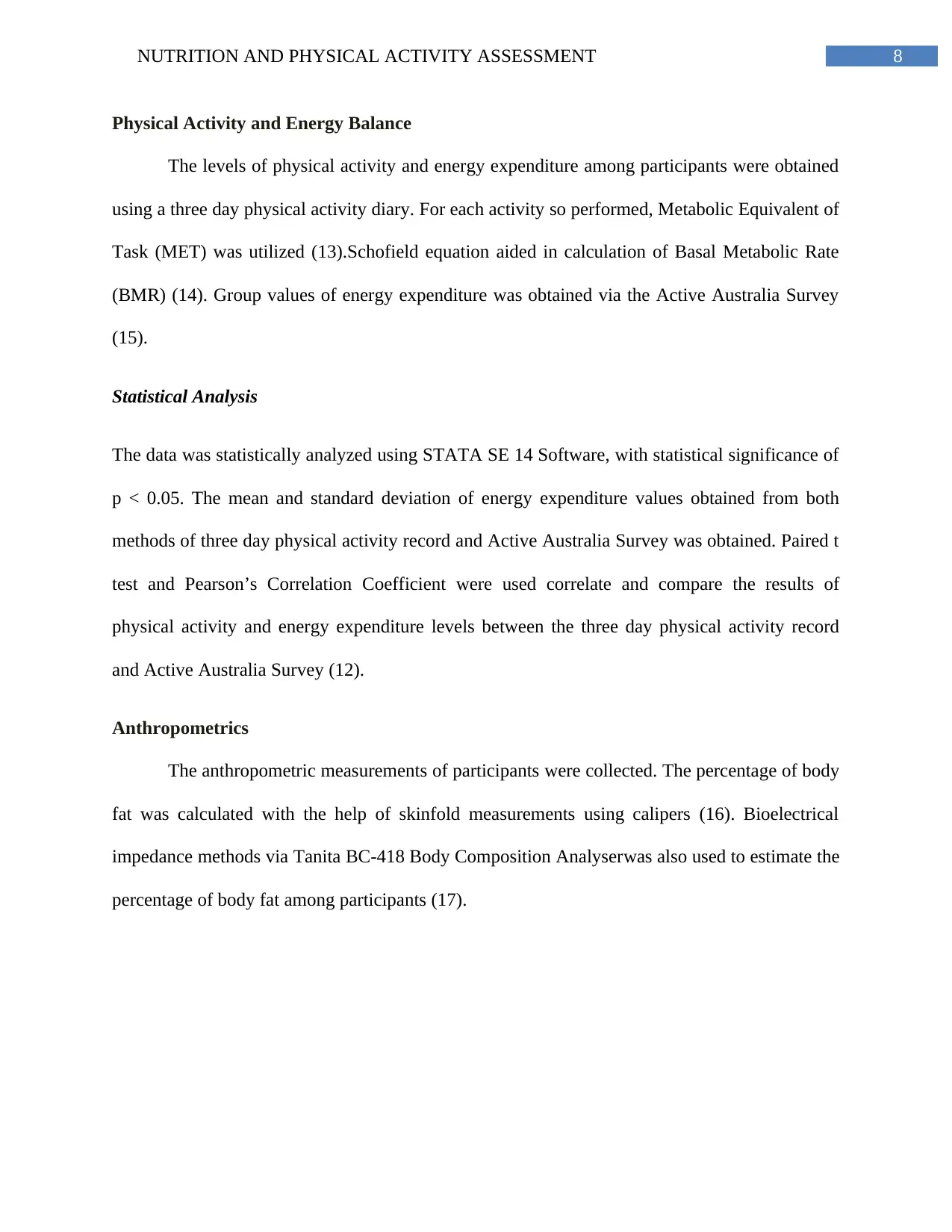
Physical Activity and Energy Balance
The levels of physical activity and energy expenditure among participants were obtained
using a three day physical activity diary. For each activity so performed, Metabolic Equivalent of
Task (MET) was utilized (13).Schofield equation aided in calculation of Basal Metabolic Rate
(BMR) (14). Group values of energy expenditure was obtained via the Active Australia Survey
(15).
Statistical Analysis
The data was statistically analyzed using STATA SE 14 Software, with statistical significance of
p < 0.05. The mean and standard deviation of energy expenditure values obtained from both
methods of three day physical activity record and Active Australia Survey was obtained. Paired t
test and Pearson’s Correlation Coefficient were used correlate and compare the results of
physical activity and energy expenditure levels between the three day physical activity record
and Active Australia Survey (12).
Anthropometrics
The anthropometric measurements of participants were collected. The percentage of body
fat was calculated with the help of skinfold measurements using calipers (16). Bioelectrical
impedance methods via Tanita BC-418 Body Composition Analyserwas also used to estimate the
percentage of body fat among participants (17).
⊘ This is a preview!⊘
Do you want full access?
Subscribe today to unlock all pages.

Trusted by 1+ million students worldwide
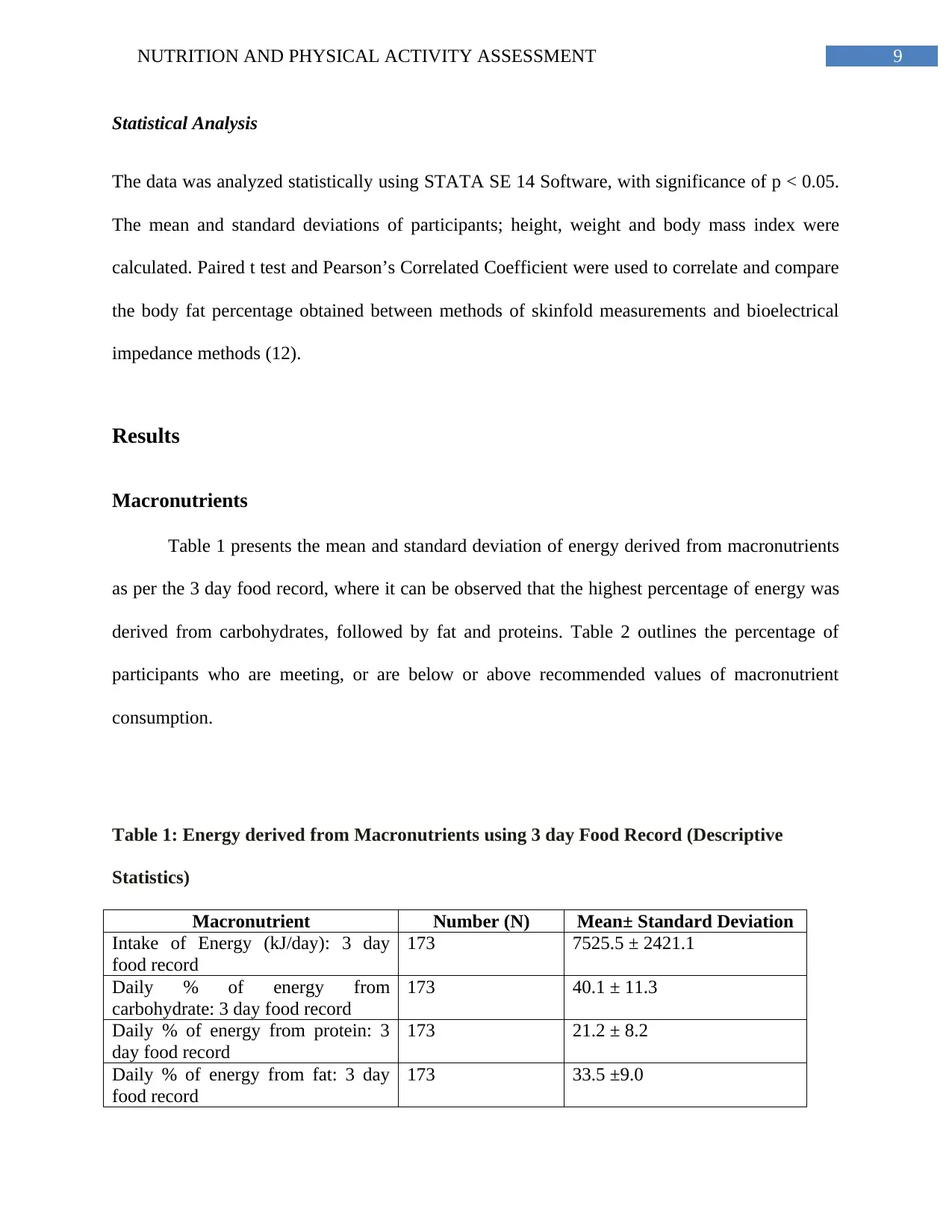
Statistical Analysis
The data was analyzed statistically using STATA SE 14 Software, with significance of p < 0.05.
The mean and standard deviations of participants; height, weight and body mass index were
calculated. Paired t test and Pearson’s Correlated Coefficient were used to correlate and compare
the body fat percentage obtained between methods of skinfold measurements and bioelectrical
impedance methods (12).
Results
Macronutrients
Table 1 presents the mean and standard deviation of energy derived from macronutrients
as per the 3 day food record, where it can be observed that the highest percentage of energy was
derived from carbohydrates, followed by fat and proteins. Table 2 outlines the percentage of
participants who are meeting, or are below or above recommended values of macronutrient
consumption.
Table 1: Energy derived from Macronutrients using 3 day Food Record (Descriptive
Statistics)
Macronutrient Number (N) Mean± Standard Deviation
Intake of Energy (kJ/day): 3 day
food record
173 7525.5 ± 2421.1
Daily % of energy from
carbohydrate: 3 day food record
173 40.1 ± 11.3
Daily % of energy from protein: 3
day food record
173 21.2 ± 8.2
Daily % of energy from fat: 3 day
food record
173 33.5 ±9.0
Paraphrase This Document
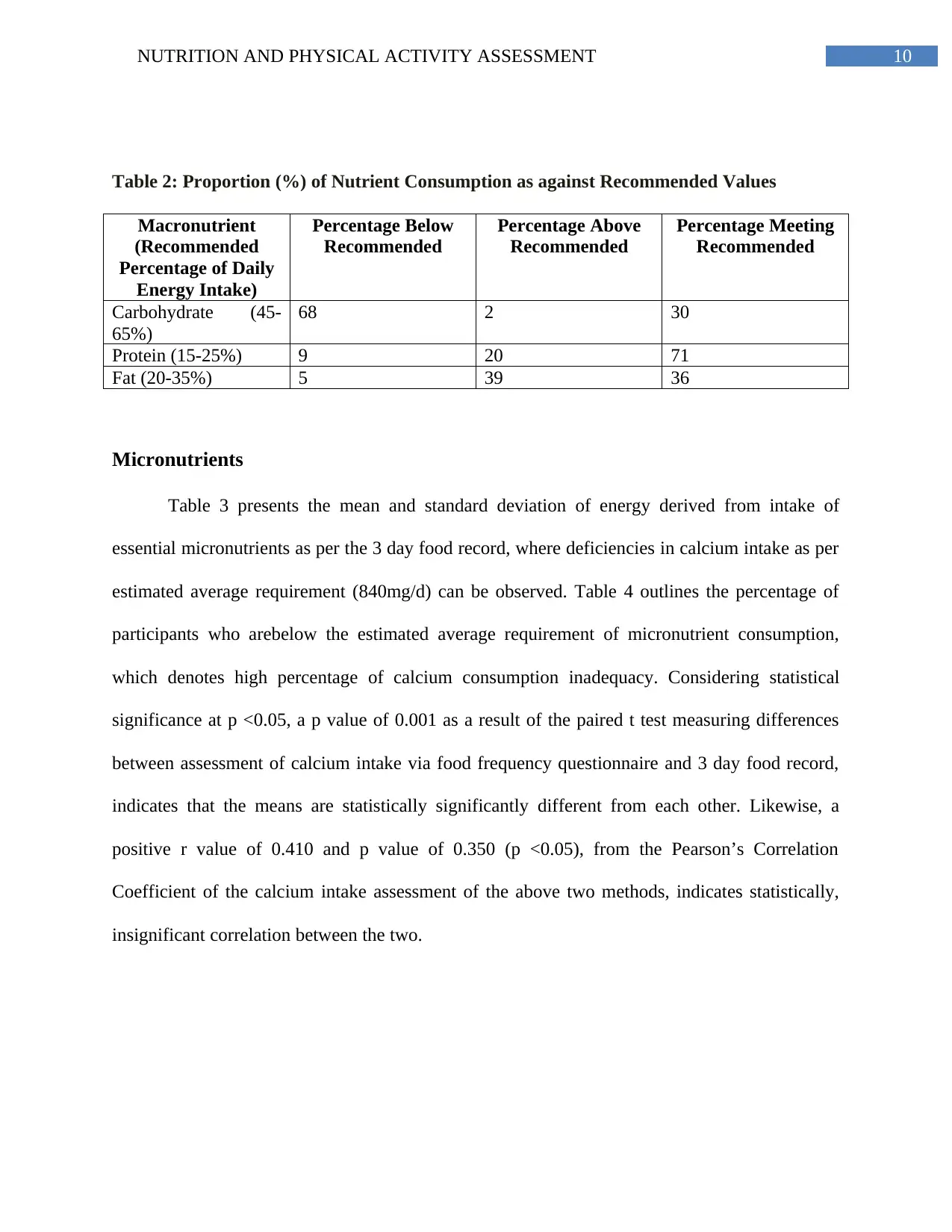
Table 2: Proportion (%) of Nutrient Consumption as against Recommended Values
Macronutrient
(Recommended
Percentage of Daily
Energy Intake)
Percentage Below
Recommended
Percentage Above
Recommended
Percentage Meeting
Recommended
Carbohydrate (45-
65%)
68 2 30
Protein (15-25%) 9 20 71
Fat (20-35%) 5 39 36
Micronutrients
Table 3 presents the mean and standard deviation of energy derived from intake of
essential micronutrients as per the 3 day food record, where deficiencies in calcium intake as per
estimated average requirement (840mg/d) can be observed. Table 4 outlines the percentage of
participants who arebelow the estimated average requirement of micronutrient consumption,
which denotes high percentage of calcium consumption inadequacy. Considering statistical
significance at p <0.05, a p value of 0.001 as a result of the paired t test measuring differences
between assessment of calcium intake via food frequency questionnaire and 3 day food record,
indicates that the means are statistically significantly different from each other. Likewise, a
positive r value of 0.410 and p value of 0.350 (p <0.05), from the Pearson’s Correlation
Coefficient of the calcium intake assessment of the above two methods, indicates statistically,
insignificant correlation between the two.
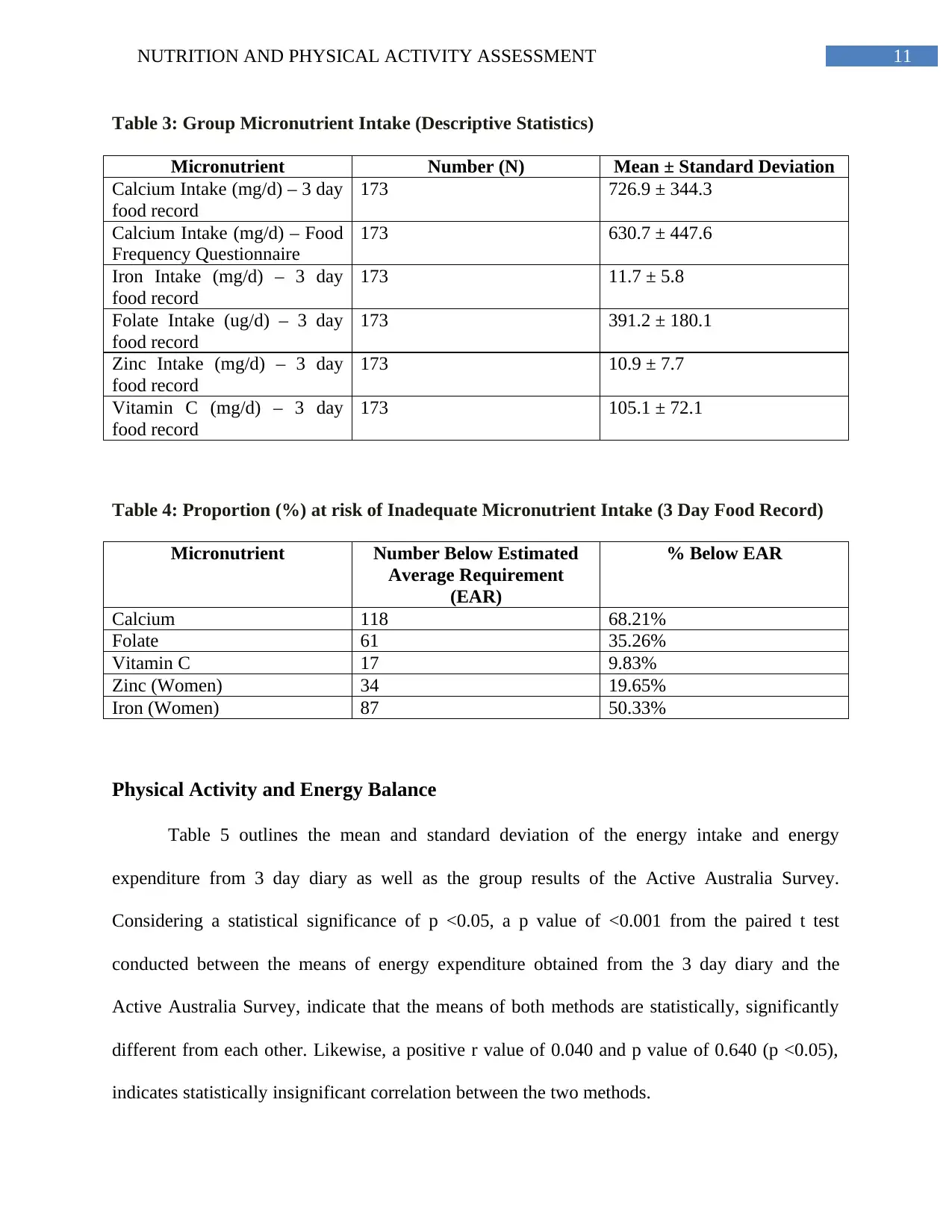
Table 3: Group Micronutrient Intake (Descriptive Statistics)
Micronutrient Number (N) Mean ± Standard Deviation
Calcium Intake (mg/d) – 3 day
food record
173 726.9 ± 344.3
Calcium Intake (mg/d) – Food
Frequency Questionnaire
173 630.7 ± 447.6
Iron Intake (mg/d) – 3 day
food record
173 11.7 ± 5.8
Folate Intake (ug/d) – 3 day
food record
173 391.2 ± 180.1
Zinc Intake (mg/d) – 3 day
food record
173 10.9 ± 7.7
Vitamin C (mg/d) – 3 day
food record
173 105.1 ± 72.1
Table 4: Proportion (%) at risk of Inadequate Micronutrient Intake (3 Day Food Record)
Micronutrient Number Below Estimated
Average Requirement
(EAR)
% Below EAR
Calcium 118 68.21%
Folate 61 35.26%
Vitamin C 17 9.83%
Zinc (Women) 34 19.65%
Iron (Women) 87 50.33%
Physical Activity and Energy Balance
Table 5 outlines the mean and standard deviation of the energy intake and energy
expenditure from 3 day diary as well as the group results of the Active Australia Survey.
Considering a statistical significance of p <0.05, a p value of <0.001 from the paired t test
conducted between the means of energy expenditure obtained from the 3 day diary and the
Active Australia Survey, indicate that the means of both methods are statistically, significantly
different from each other. Likewise, a positive r value of 0.040 and p value of 0.640 (p <0.05),
indicates statistically insignificant correlation between the two methods.
⊘ This is a preview!⊘
Do you want full access?
Subscribe today to unlock all pages.

Trusted by 1+ million students worldwide
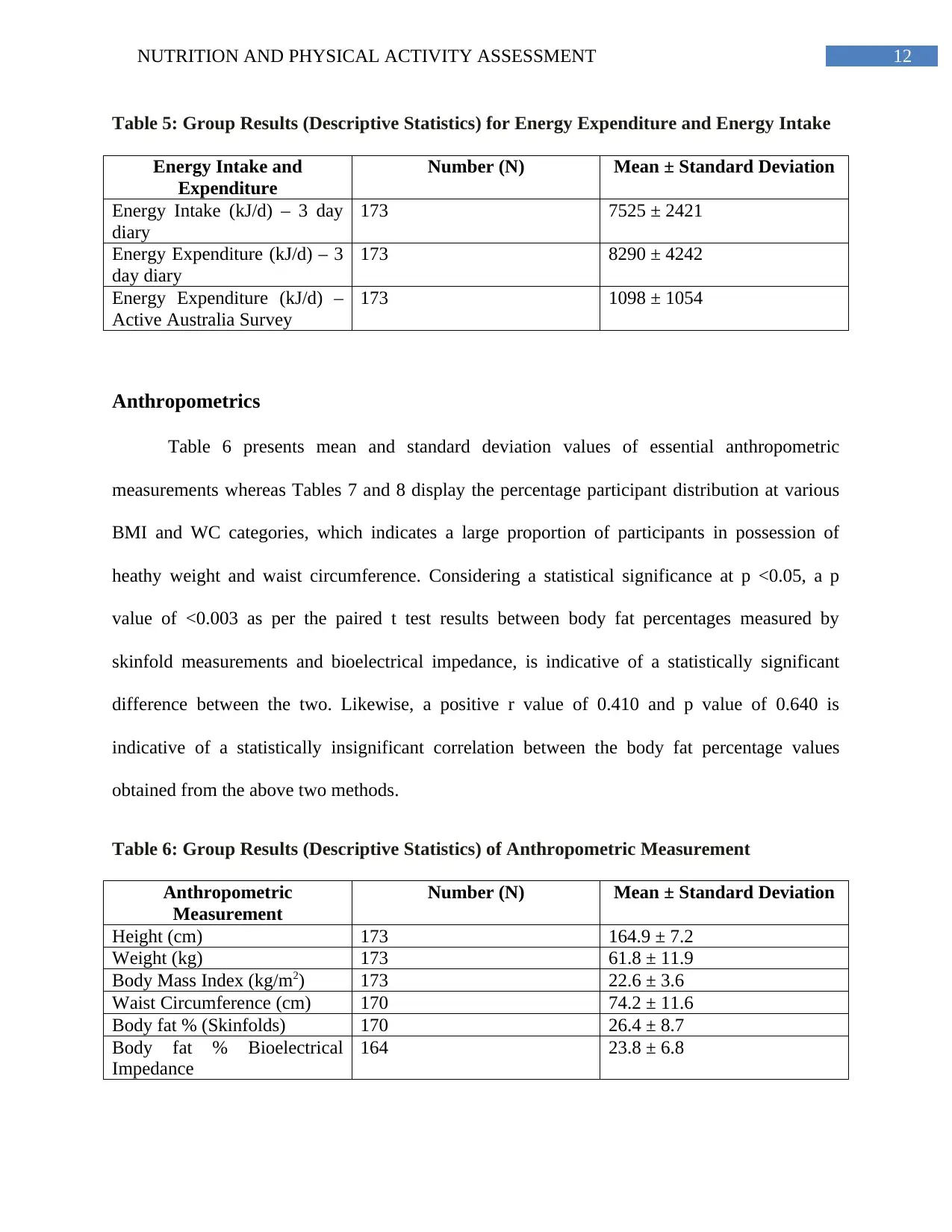
Table 5: Group Results (Descriptive Statistics) for Energy Expenditure and Energy Intake
Energy Intake and
Expenditure
Number (N) Mean ± Standard Deviation
Energy Intake (kJ/d) – 3 day
diary
173 7525 ± 2421
Energy Expenditure (kJ/d) – 3
day diary
173 8290 ± 4242
Energy Expenditure (kJ/d) –
Active Australia Survey
173 1098 ± 1054
Anthropometrics
Table 6 presents mean and standard deviation values of essential anthropometric
measurements whereas Tables 7 and 8 display the percentage participant distribution at various
BMI and WC categories, which indicates a large proportion of participants in possession of
heathy weight and waist circumference. Considering a statistical significance at p <0.05, a p
value of <0.003 as per the paired t test results between body fat percentages measured by
skinfold measurements and bioelectrical impedance, is indicative of a statistically significant
difference between the two. Likewise, a positive r value of 0.410 and p value of 0.640 is
indicative of a statistically insignificant correlation between the body fat percentage values
obtained from the above two methods.
Table 6: Group Results (Descriptive Statistics) of Anthropometric Measurement
Anthropometric
Measurement
Number (N) Mean ± Standard Deviation
Height (cm) 173 164.9 ± 7.2
Weight (kg) 173 61.8 ± 11.9
Body Mass Index (kg/m2) 173 22.6 ± 3.6
Waist Circumference (cm) 170 74.2 ± 11.6
Body fat % (Skinfolds) 170 26.4 ± 8.7
Body fat % Bioelectrical
Impedance
164 23.8 ± 6.8
Paraphrase This Document

Table 7: Participant Proportion (%) in each Waist Circumference (WC) Category
WC Category Number (N) Percent (%)
WC <80 cm 127 74.7
WC =>80 cm 30 17.7
WC => 88 cm 13 7.7
Total 170 100
Table 8: Participant Proportion (%) in each Body Mass Index (BMI) Category
BMI Category Number (N) Percent (%)
Underweight <18.5 kg/m2 13 7.51
Healthy Weight 18.5 – 24.99
kg/m2
128 73.99
Overweight =>25.0 – 25.99
kg/m2
24 13.87
Obese => 30.0 kg/m2 8 4.62
Total 173 100
Discussion
Major Findings
Carbohydrates contributed the highest percentage of energy consumption followed by
fats and proteins. A large proportion (68%) were found to consume carbohydrates below the
recommended levels. The study uncovered adequate mean consumption of all micronutrients,
except calcium, which was found to be 726.9 mg/day as per the EAR of 840 mg/ day. A
significant percentage of participants were reported to consume dietary calcium and iron below
the EAR values, which is 68.21 % and 50.33 % respectively. Significant differences in values of
energy expenditures reported by both methods of three day diary and Active Australia Survey
were observed. The anthropometric measurements reported a significant percentage of
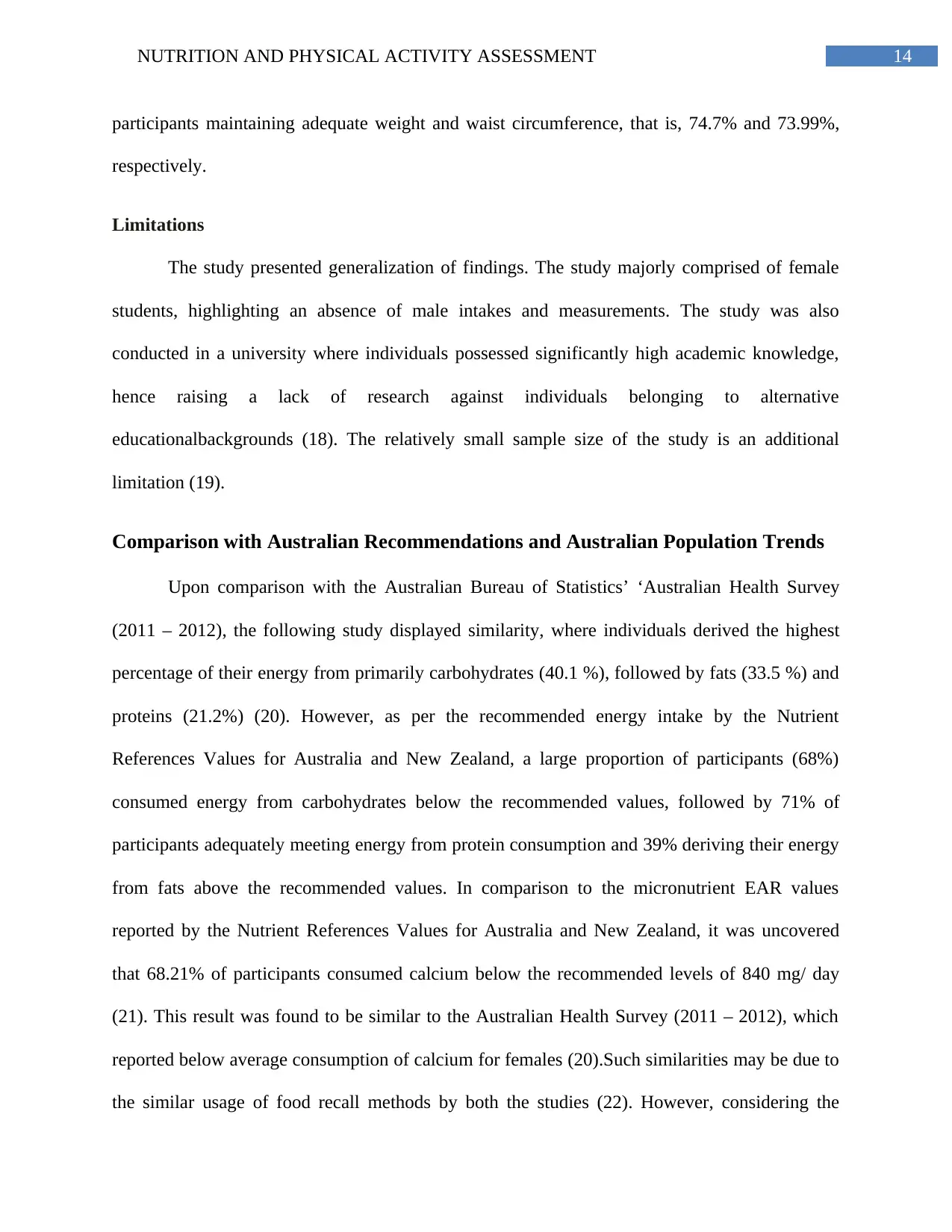
participants maintaining adequate weight and waist circumference, that is, 74.7% and 73.99%,
respectively.
Limitations
The study presented generalization of findings. The study majorly comprised of female
students, highlighting an absence of male intakes and measurements. The study was also
conducted in a university where individuals possessed significantly high academic knowledge,
hence raising a lack of research against individuals belonging to alternative
educationalbackgrounds (18). The relatively small sample size of the study is an additional
limitation (19).
Comparison with Australian Recommendations and Australian Population Trends
Upon comparison with the Australian Bureau of Statistics’ ‘Australian Health Survey
(2011 – 2012), the following study displayed similarity, where individuals derived the highest
percentage of their energy from primarily carbohydrates (40.1 %), followed by fats (33.5 %) and
proteins (21.2%) (20). However, as per the recommended energy intake by the Nutrient
References Values for Australia and New Zealand, a large proportion of participants (68%)
consumed energy from carbohydrates below the recommended values, followed by 71% of
participants adequately meeting energy from protein consumption and 39% deriving their energy
from fats above the recommended values. In comparison to the micronutrient EAR values
reported by the Nutrient References Values for Australia and New Zealand, it was uncovered
that 68.21% of participants consumed calcium below the recommended levels of 840 mg/ day
(21). This result was found to be similar to the Australian Health Survey (2011 – 2012), which
reported below average consumption of calcium for females (20).Such similarities may be due to
the similar usage of food recall methods by both the studies (22). However, considering the
⊘ This is a preview!⊘
Do you want full access?
Subscribe today to unlock all pages.

Trusted by 1+ million students worldwide
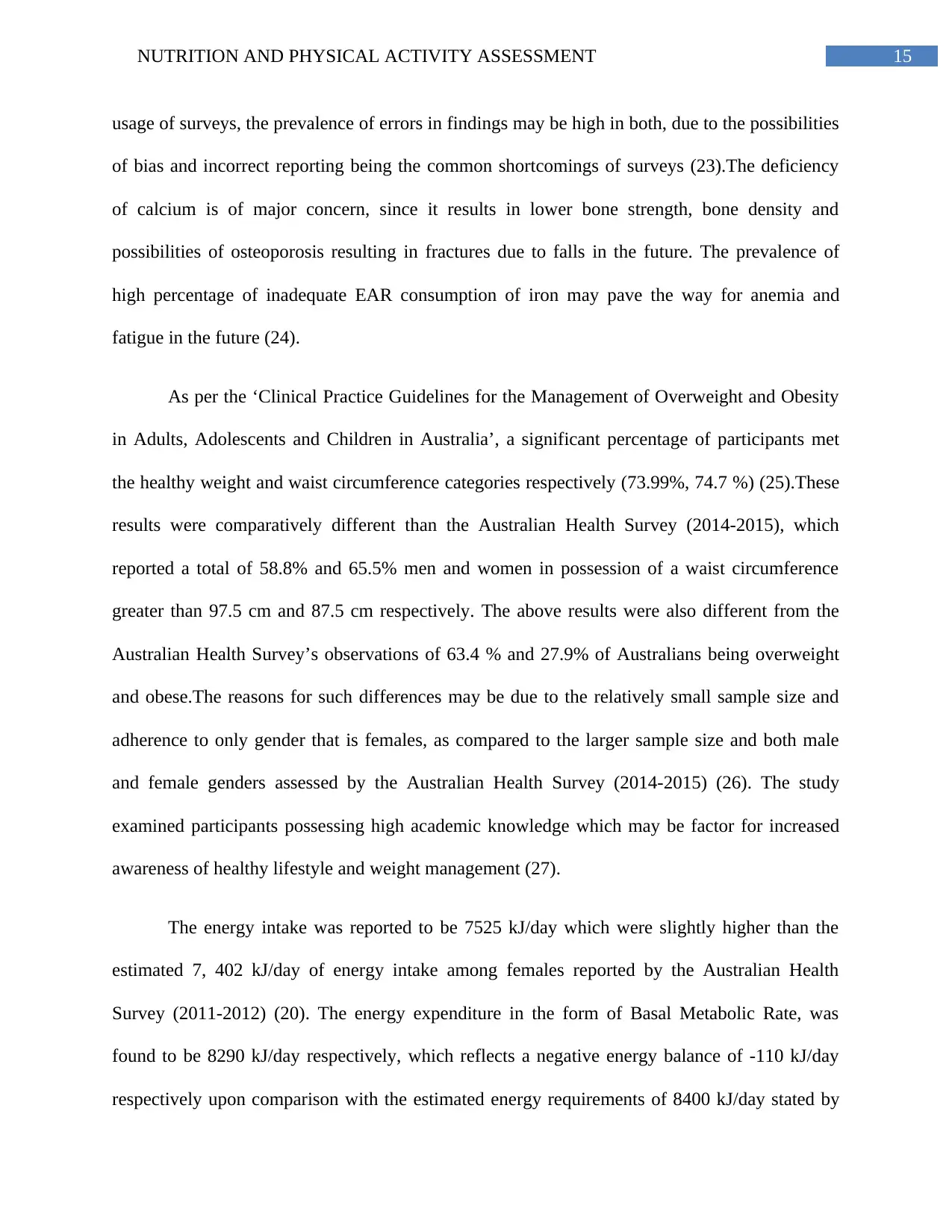
usage of surveys, the prevalence of errors in findings may be high in both, due to the possibilities
of bias and incorrect reporting being the common shortcomings of surveys (23).The deficiency
of calcium is of major concern, since it results in lower bone strength, bone density and
possibilities of osteoporosis resulting in fractures due to falls in the future. The prevalence of
high percentage of inadequate EAR consumption of iron may pave the way for anemia and
fatigue in the future (24).
As per the ‘Clinical Practice Guidelines for the Management of Overweight and Obesity
in Adults, Adolescents and Children in Australia’, a significant percentage of participants met
the healthy weight and waist circumference categories respectively (73.99%, 74.7 %) (25).These
results were comparatively different than the Australian Health Survey (2014-2015), which
reported a total of 58.8% and 65.5% men and women in possession of a waist circumference
greater than 97.5 cm and 87.5 cm respectively. The above results were also different from the
Australian Health Survey’s observations of 63.4 % and 27.9% of Australians being overweight
and obese.The reasons for such differences may be due to the relatively small sample size and
adherence to only gender that is females, as compared to the larger sample size and both male
and female genders assessed by the Australian Health Survey (2014-2015) (26). The study
examined participants possessing high academic knowledge which may be factor for increased
awareness of healthy lifestyle and weight management (27).
The energy intake was reported to be 7525 kJ/day which were slightly higher than the
estimated 7, 402 kJ/day of energy intake among females reported by the Australian Health
Survey (2011-2012) (20). The energy expenditure in the form of Basal Metabolic Rate, was
found to be 8290 kJ/day respectively, which reflects a negative energy balance of -110 kJ/day
respectively upon comparison with the estimated energy requirements of 8400 kJ/day stated by
Paraphrase This Document
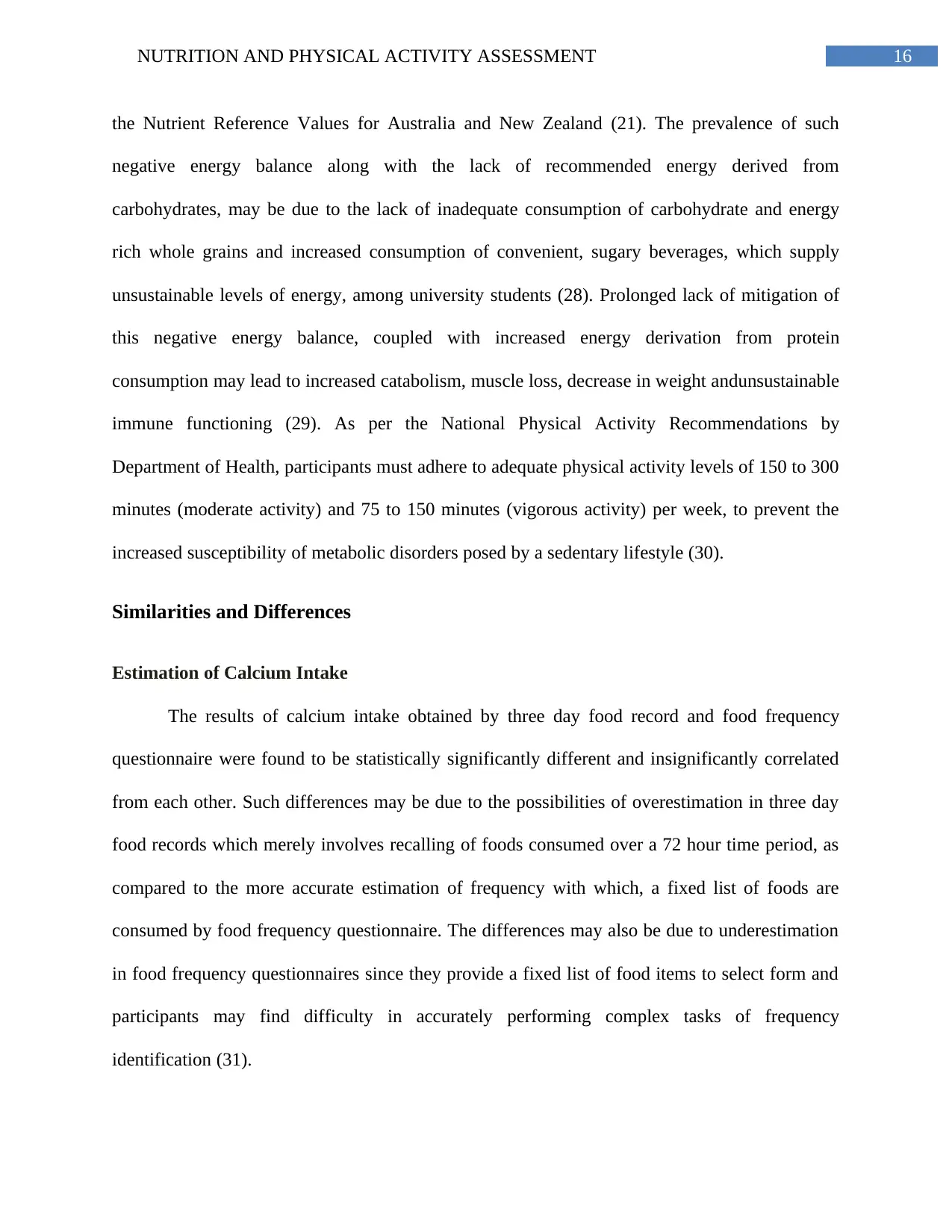
the Nutrient Reference Values for Australia and New Zealand (21). The prevalence of such
negative energy balance along with the lack of recommended energy derived from
carbohydrates, may be due to the lack of inadequate consumption of carbohydrate and energy
rich whole grains and increased consumption of convenient, sugary beverages, which supply
unsustainable levels of energy, among university students (28). Prolonged lack of mitigation of
this negative energy balance, coupled with increased energy derivation from protein
consumption may lead to increased catabolism, muscle loss, decrease in weight andunsustainable
immune functioning (29). As per the National Physical Activity Recommendations by
Department of Health, participants must adhere to adequate physical activity levels of 150 to 300
minutes (moderate activity) and 75 to 150 minutes (vigorous activity) per week, to prevent the
increased susceptibility of metabolic disorders posed by a sedentary lifestyle (30).
Similarities and Differences
Estimation of Calcium Intake
The results of calcium intake obtained by three day food record and food frequency
questionnaire were found to be statistically significantly different and insignificantly correlated
from each other. Such differences may be due to the possibilities of overestimation in three day
food records which merely involves recalling of foods consumed over a 72 hour time period, as
compared to the more accurate estimation of frequency with which, a fixed list of foods are
consumed by food frequency questionnaire. The differences may also be due to underestimation
in food frequency questionnaires since they provide a fixed list of food items to select form and
participants may find difficulty in accurately performing complex tasks of frequency
identification (31).
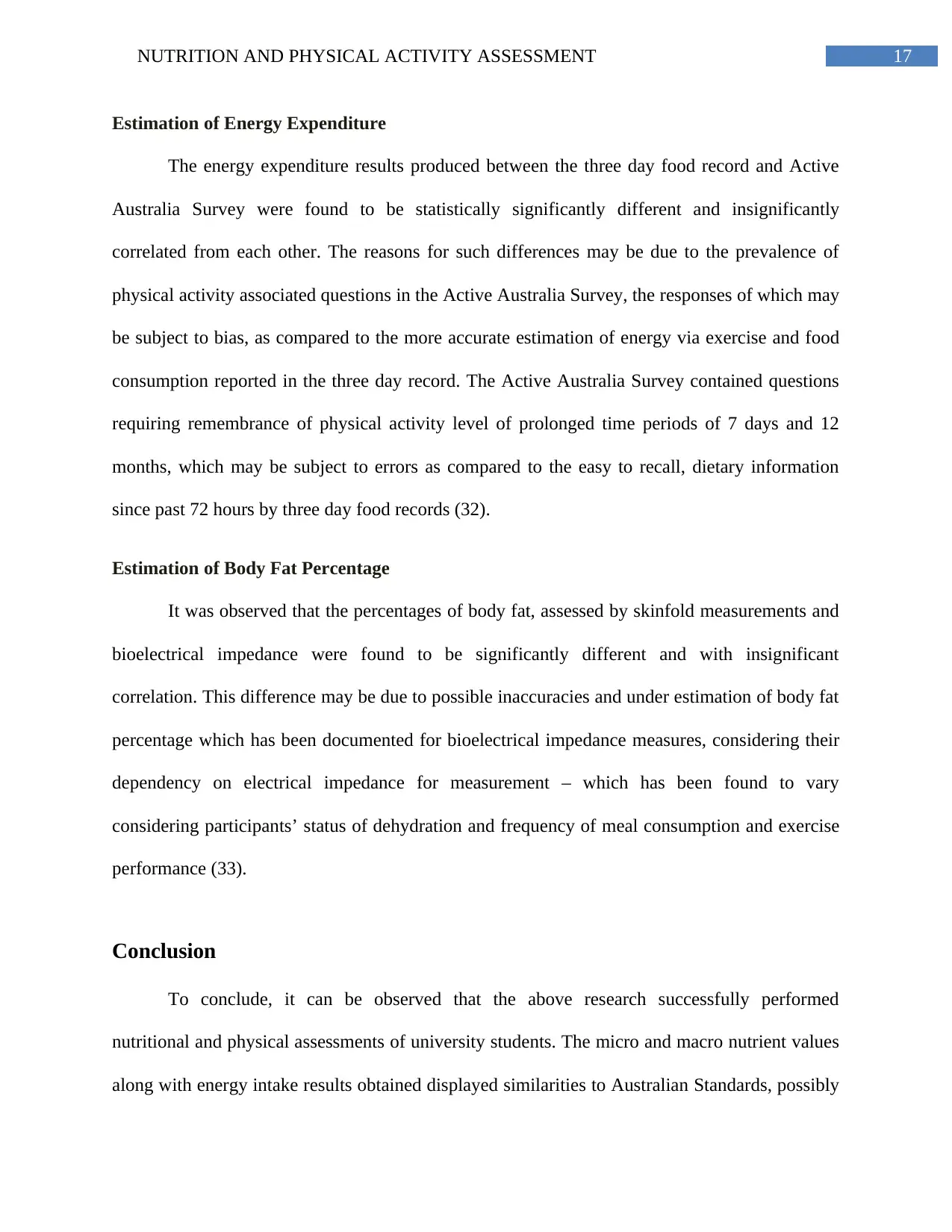
Estimation of Energy Expenditure
The energy expenditure results produced between the three day food record and Active
Australia Survey were found to be statistically significantly different and insignificantly
correlated from each other. The reasons for such differences may be due to the prevalence of
physical activity associated questions in the Active Australia Survey, the responses of which may
be subject to bias, as compared to the more accurate estimation of energy via exercise and food
consumption reported in the three day record. The Active Australia Survey contained questions
requiring remembrance of physical activity level of prolonged time periods of 7 days and 12
months, which may be subject to errors as compared to the easy to recall, dietary information
since past 72 hours by three day food records (32).
Estimation of Body Fat Percentage
It was observed that the percentages of body fat, assessed by skinfold measurements and
bioelectrical impedance were found to be significantly different and with insignificant
correlation. This difference may be due to possible inaccuracies and under estimation of body fat
percentage which has been documented for bioelectrical impedance measures, considering their
dependency on electrical impedance for measurement – which has been found to vary
considering participants’ status of dehydration and frequency of meal consumption and exercise
performance (33).
Conclusion
To conclude, it can be observed that the above research successfully performed
nutritional and physical assessments of university students. The micro and macro nutrient values
along with energy intake results obtained displayed similarities to Australian Standards, possibly
⊘ This is a preview!⊘
Do you want full access?
Subscribe today to unlock all pages.

Trusted by 1+ million students worldwide
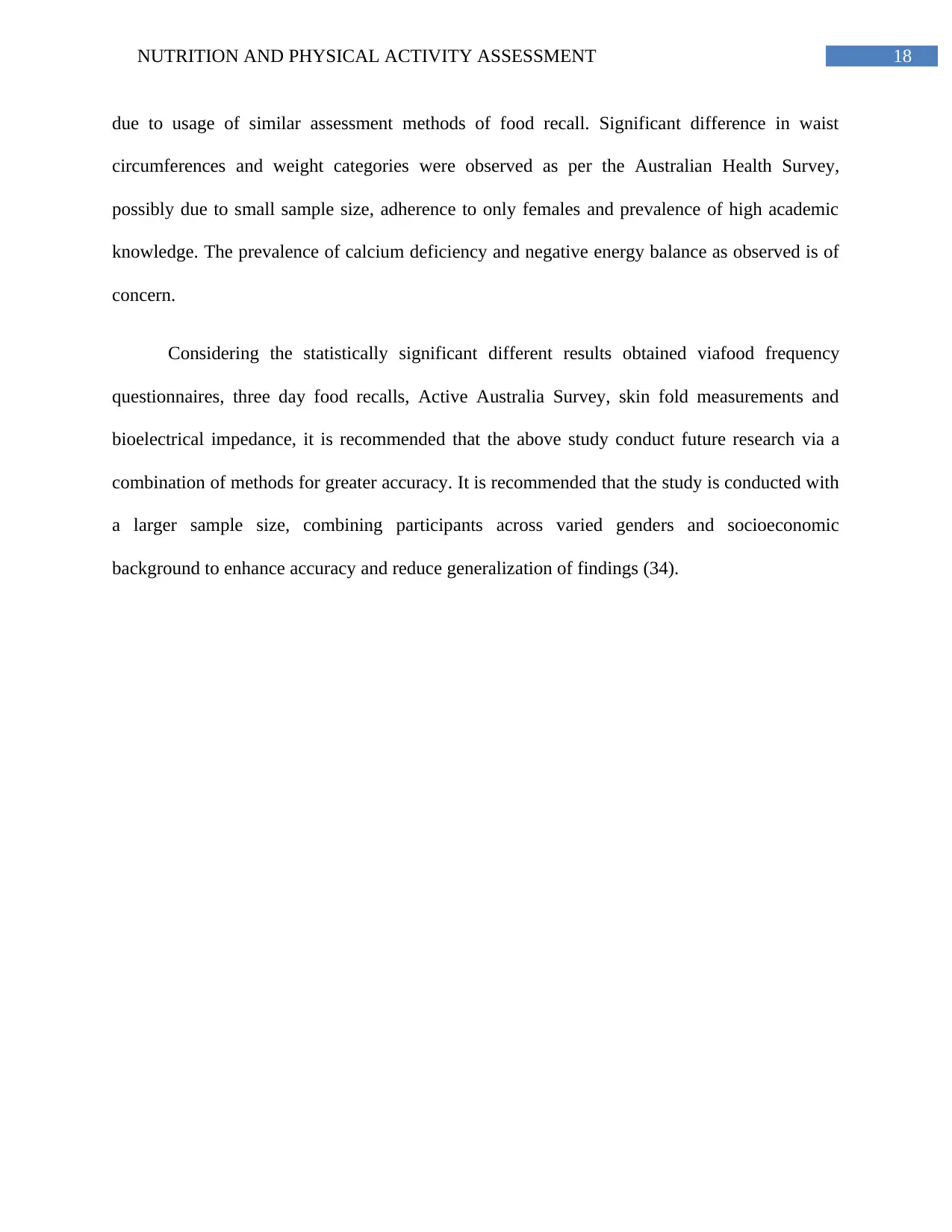
due to usage of similar assessment methods of food recall. Significant difference in waist
circumferences and weight categories were observed as per the Australian Health Survey,
possibly due to small sample size, adherence to only females and prevalence of high academic
knowledge. The prevalence of calcium deficiency and negative energy balance as observed is of
concern.
Considering the statistically significant different results obtained viafood frequency
questionnaires, three day food recalls, Active Australia Survey, skin fold measurements and
bioelectrical impedance, it is recommended that the above study conduct future research via a
combination of methods for greater accuracy. It is recommended that the study is conducted with
a larger sample size, combining participants across varied genders and socioeconomic
background to enhance accuracy and reduce generalization of findings (34).
Paraphrase This Document
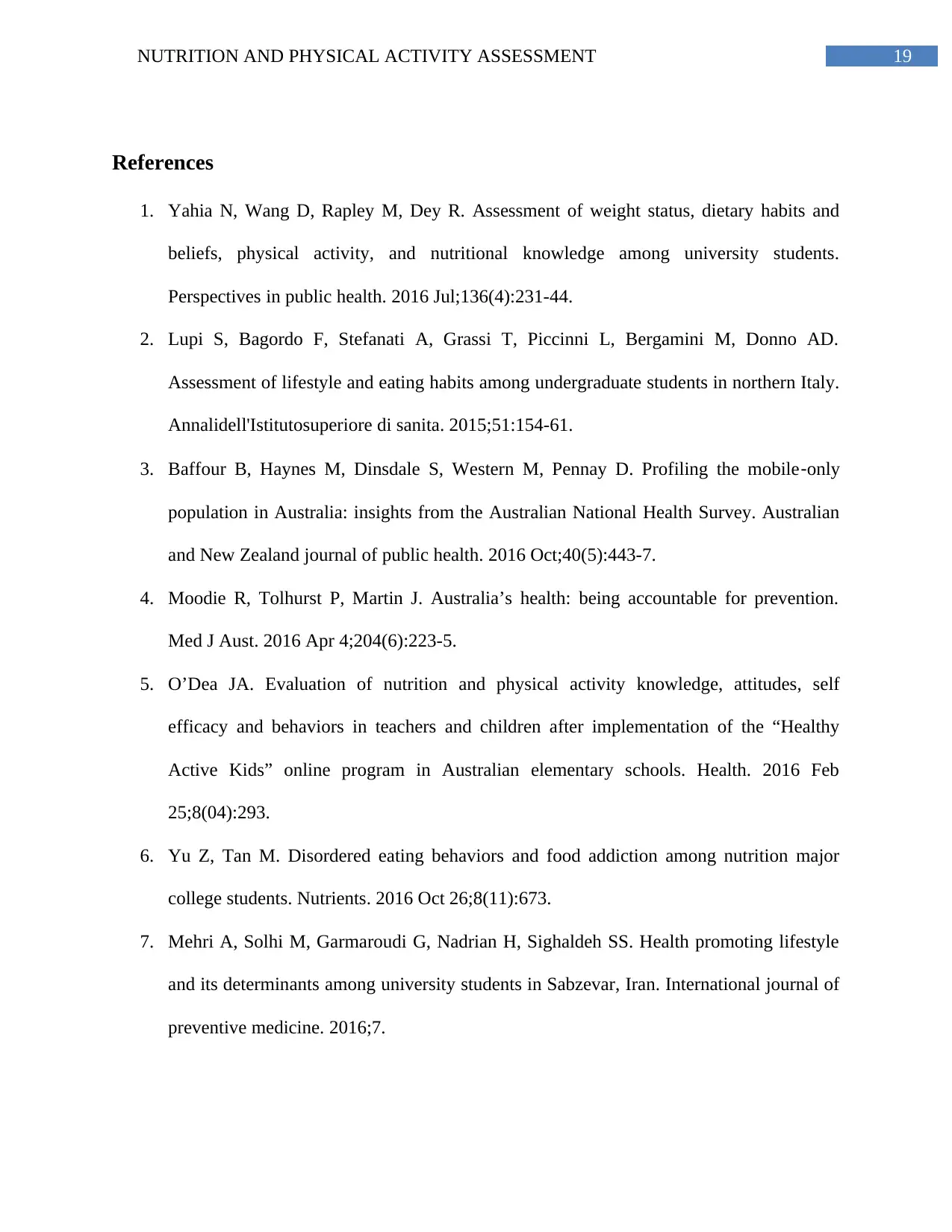
References
1. Yahia N, Wang D, Rapley M, Dey R. Assessment of weight status, dietary habits and
beliefs, physical activity, and nutritional knowledge among university students.
Perspectives in public health. 2016 Jul;136(4):231-44.
2. Lupi S, Bagordo F, Stefanati A, Grassi T, Piccinni L, Bergamini M, Donno AD.
Assessment of lifestyle and eating habits among undergraduate students in northern Italy.
Annalidell'Istitutosuperiore di sanita. 2015;51:154-61.
3. Baffour B, Haynes M, Dinsdale S, Western M, Pennay D. Profiling the mobile‐only
population in Australia: insights from the Australian National Health Survey. Australian
and New Zealand journal of public health. 2016 Oct;40(5):443-7.
4. Moodie R, Tolhurst P, Martin J. Australia’s health: being accountable for prevention.
Med J Aust. 2016 Apr 4;204(6):223-5.
5. O’Dea JA. Evaluation of nutrition and physical activity knowledge, attitudes, self
efficacy and behaviors in teachers and children after implementation of the “Healthy
Active Kids” online program in Australian elementary schools. Health. 2016 Feb
25;8(04):293.
6. Yu Z, Tan M. Disordered eating behaviors and food addiction among nutrition major
college students. Nutrients. 2016 Oct 26;8(11):673.
7. Mehri A, Solhi M, Garmaroudi G, Nadrian H, Sighaldeh SS. Health promoting lifestyle
and its determinants among university students in Sabzevar, Iran. International journal of
preventive medicine. 2016;7.
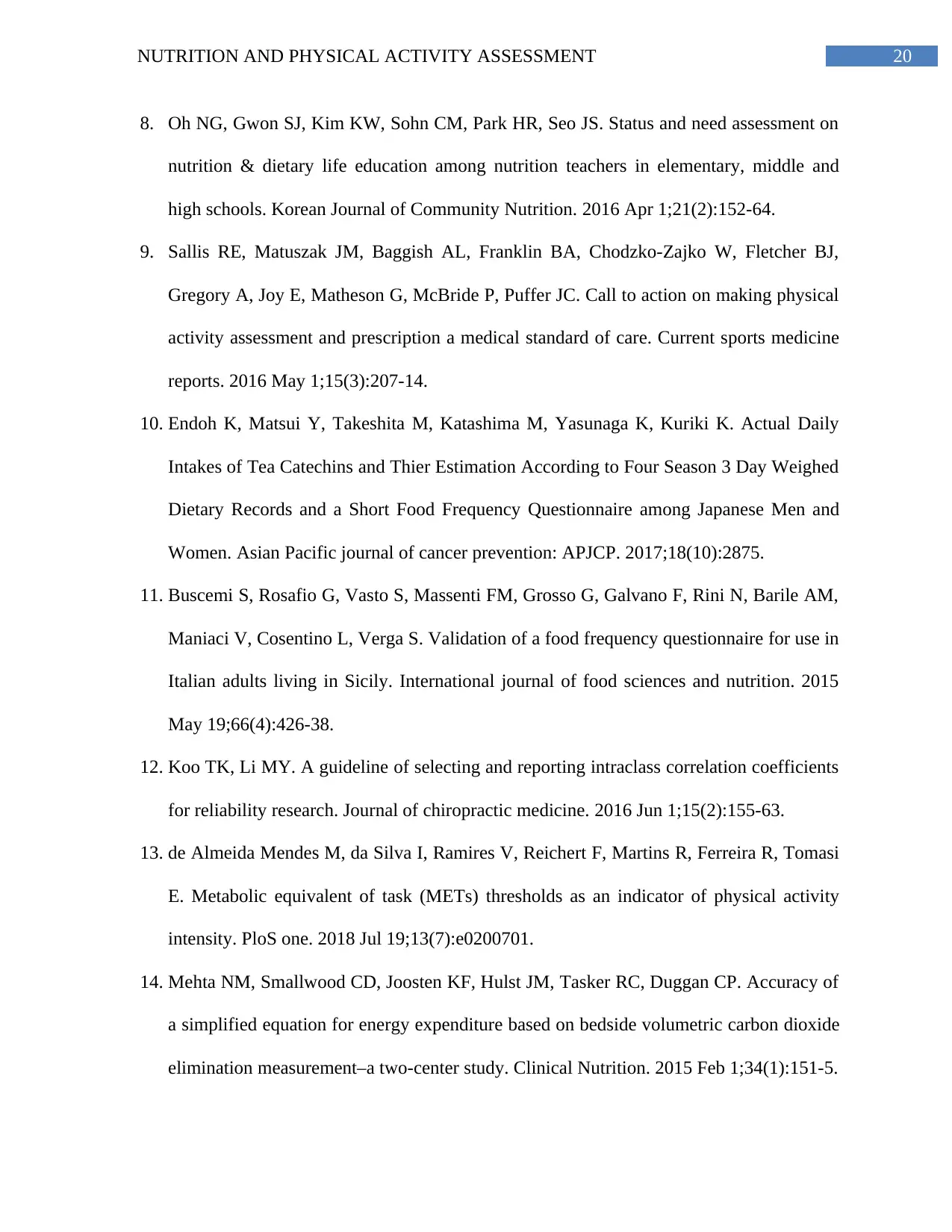
8. Oh NG, Gwon SJ, Kim KW, Sohn CM, Park HR, Seo JS. Status and need assessment on
nutrition & dietary life education among nutrition teachers in elementary, middle and
high schools. Korean Journal of Community Nutrition. 2016 Apr 1;21(2):152-64.
9. Sallis RE, Matuszak JM, Baggish AL, Franklin BA, Chodzko-Zajko W, Fletcher BJ,
Gregory A, Joy E, Matheson G, McBride P, Puffer JC. Call to action on making physical
activity assessment and prescription a medical standard of care. Current sports medicine
reports. 2016 May 1;15(3):207-14.
10. Endoh K, Matsui Y, Takeshita M, Katashima M, Yasunaga K, Kuriki K. Actual Daily
Intakes of Tea Catechins and Thier Estimation According to Four Season 3 Day Weighed
Dietary Records and a Short Food Frequency Questionnaire among Japanese Men and
Women. Asian Pacific journal of cancer prevention: APJCP. 2017;18(10):2875.
11. Buscemi S, Rosafio G, Vasto S, Massenti FM, Grosso G, Galvano F, Rini N, Barile AM,
Maniaci V, Cosentino L, Verga S. Validation of a food frequency questionnaire for use in
Italian adults living in Sicily. International journal of food sciences and nutrition. 2015
May 19;66(4):426-38.
12. Koo TK, Li MY. A guideline of selecting and reporting intraclass correlation coefficients
for reliability research. Journal of chiropractic medicine. 2016 Jun 1;15(2):155-63.
13. de Almeida Mendes M, da Silva I, Ramires V, Reichert F, Martins R, Ferreira R, Tomasi
E. Metabolic equivalent of task (METs) thresholds as an indicator of physical activity
intensity. PloS one. 2018 Jul 19;13(7):e0200701.
14. Mehta NM, Smallwood CD, Joosten KF, Hulst JM, Tasker RC, Duggan CP. Accuracy of
a simplified equation for energy expenditure based on bedside volumetric carbon dioxide
elimination measurement–a two-center study. Clinical Nutrition. 2015 Feb 1;34(1):151-5.
⊘ This is a preview!⊘
Do you want full access?
Subscribe today to unlock all pages.

Trusted by 1+ million students worldwide
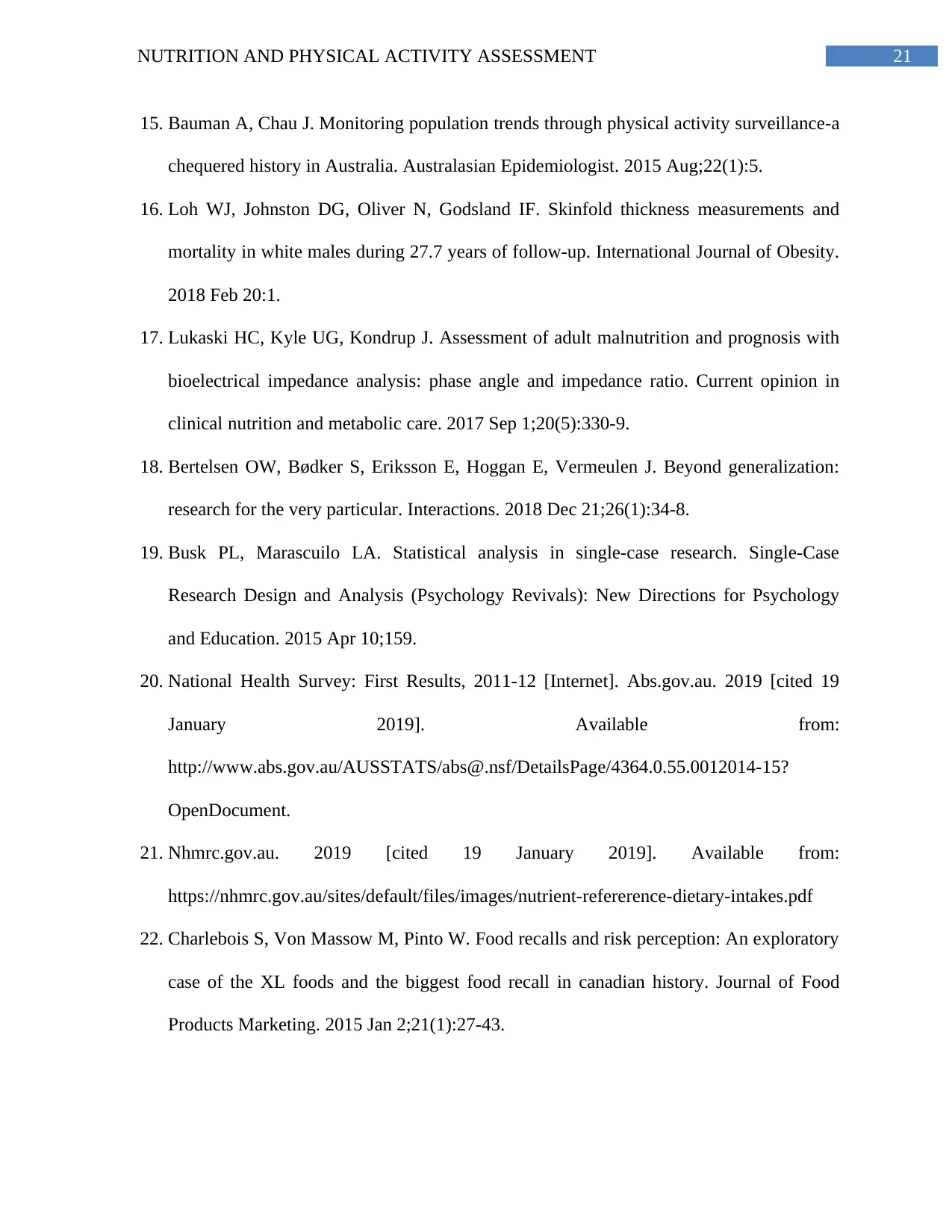
15. Bauman A, Chau J. Monitoring population trends through physical activity surveillance-a
chequered history in Australia. Australasian Epidemiologist. 2015 Aug;22(1):5.
16. Loh WJ, Johnston DG, Oliver N, Godsland IF. Skinfold thickness measurements and
mortality in white males during 27.7 years of follow-up. International Journal of Obesity.
2018 Feb 20:1.
17. Lukaski HC, Kyle UG, Kondrup J. Assessment of adult malnutrition and prognosis with
bioelectrical impedance analysis: phase angle and impedance ratio. Current opinion in
clinical nutrition and metabolic care. 2017 Sep 1;20(5):330-9.
18. Bertelsen OW, Bødker S, Eriksson E, Hoggan E, Vermeulen J. Beyond generalization:
research for the very particular. Interactions. 2018 Dec 21;26(1):34-8.
19. Busk PL, Marascuilo LA. Statistical analysis in single-case research. Single-Case
Research Design and Analysis (Psychology Revivals): New Directions for Psychology
and Education. 2015 Apr 10;159.
20. National Health Survey: First Results, 2011-12 [Internet]. Abs.gov.au. 2019 [cited 19
January 2019]. Available from:
http://www.abs.gov.au/AUSSTATS/abs@.nsf/DetailsPage/4364.0.55.0012014-15?
OpenDocument.
21. Nhmrc.gov.au. 2019 [cited 19 January 2019]. Available from:
https://nhmrc.gov.au/sites/default/files/images/nutrient-refererence-dietary-intakes.pdf
22. Charlebois S, Von Massow M, Pinto W. Food recalls and risk perception: An exploratory
case of the XL foods and the biggest food recall in canadian history. Journal of Food
Products Marketing. 2015 Jan 2;21(1):27-43.
Paraphrase This Document
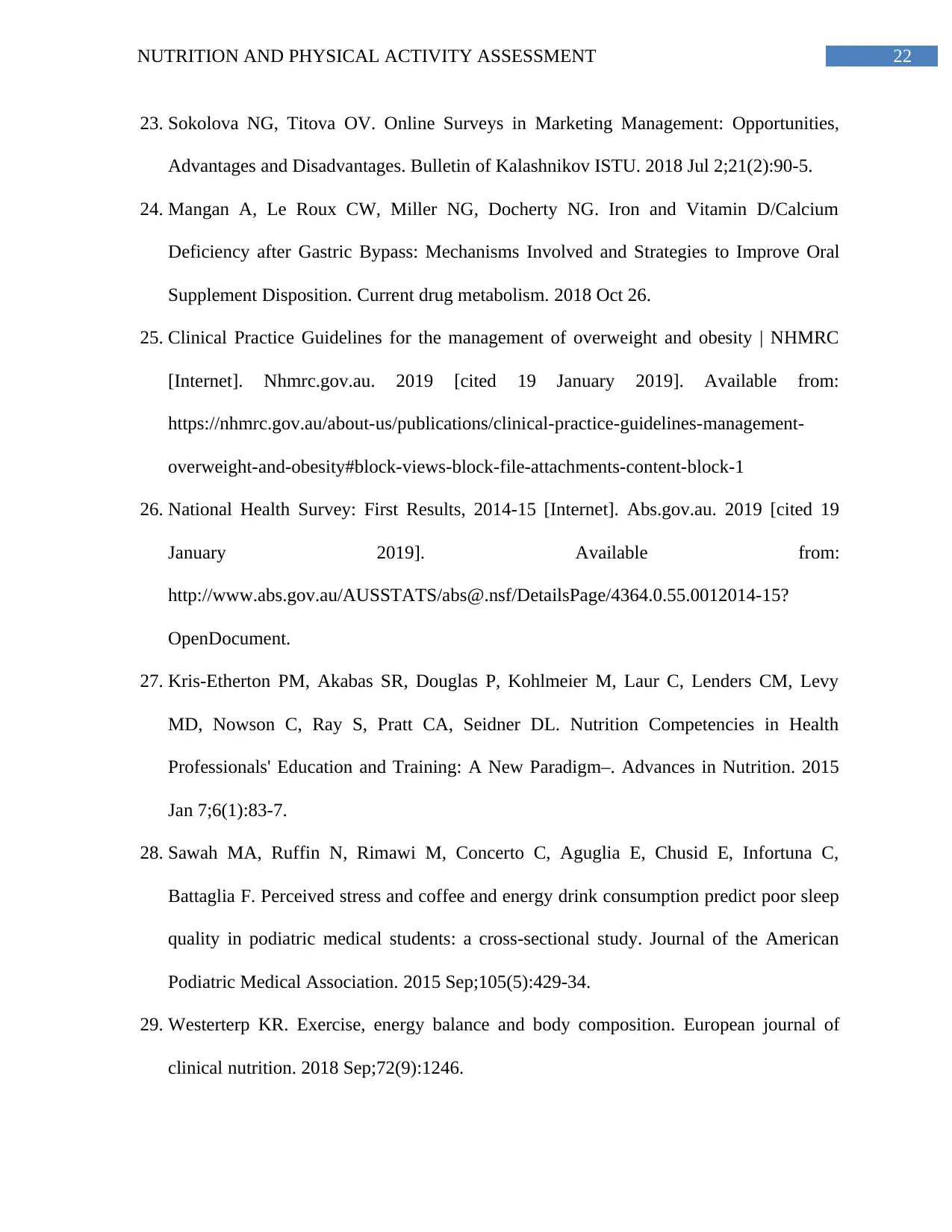
23. Sokolova NG, Titova OV. Online Surveys in Marketing Management: Opportunities,
Advantages and Disadvantages. Bulletin of Kalashnikov ISTU. 2018 Jul 2;21(2):90-5.
24. Mangan A, Le Roux CW, Miller NG, Docherty NG. Iron and Vitamin D/Calcium
Deficiency after Gastric Bypass: Mechanisms Involved and Strategies to Improve Oral
Supplement Disposition. Current drug metabolism. 2018 Oct 26.
25. Clinical Practice Guidelines for the management of overweight and obesity | NHMRC
[Internet]. Nhmrc.gov.au. 2019 [cited 19 January 2019]. Available from:
https://nhmrc.gov.au/about-us/publications/clinical-practice-guidelines-management-
overweight-and-obesity#block-views-block-file-attachments-content-block-1
26. National Health Survey: First Results, 2014-15 [Internet]. Abs.gov.au. 2019 [cited 19
January 2019]. Available from:
http://www.abs.gov.au/AUSSTATS/abs@.nsf/DetailsPage/4364.0.55.0012014-15?
OpenDocument.
27. Kris-Etherton PM, Akabas SR, Douglas P, Kohlmeier M, Laur C, Lenders CM, Levy
MD, Nowson C, Ray S, Pratt CA, Seidner DL. Nutrition Competencies in Health
Professionals' Education and Training: A New Paradigm–. Advances in Nutrition. 2015
Jan 7;6(1):83-7.
28. Sawah MA, Ruffin N, Rimawi M, Concerto C, Aguglia E, Chusid E, Infortuna C,
Battaglia F. Perceived stress and coffee and energy drink consumption predict poor sleep
quality in podiatric medical students: a cross-sectional study. Journal of the American
Podiatric Medical Association. 2015 Sep;105(5):429-34.
29. Westerterp KR. Exercise, energy balance and body composition. European journal of
clinical nutrition. 2018 Sep;72(9):1246.
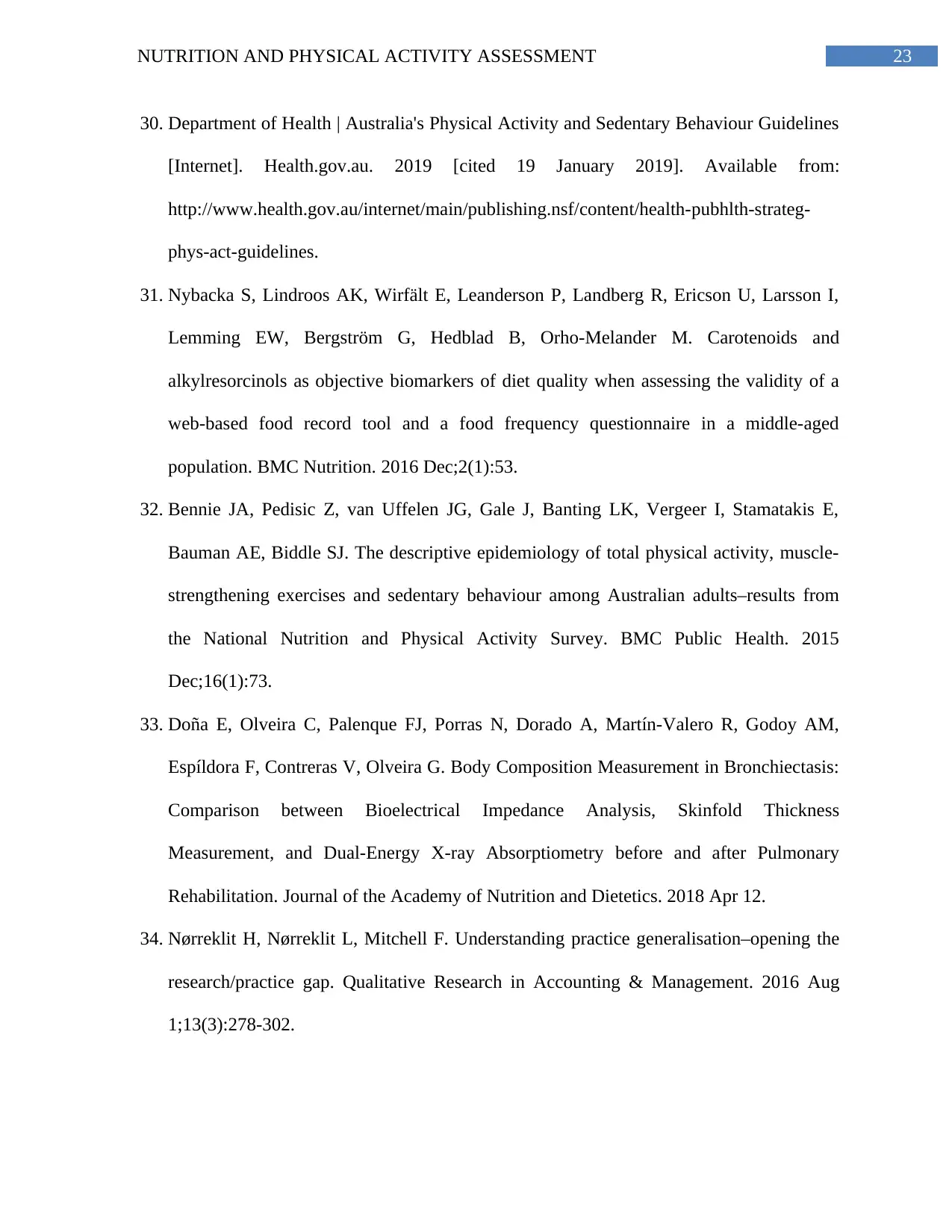
30. Department of Health | Australia's Physical Activity and Sedentary Behaviour Guidelines
[Internet]. Health.gov.au. 2019 [cited 19 January 2019]. Available from:
http://www.health.gov.au/internet/main/publishing.nsf/content/health-pubhlth-strateg-
phys-act-guidelines.
31. Nybacka S, Lindroos AK, Wirfält E, Leanderson P, Landberg R, Ericson U, Larsson I,
Lemming EW, Bergström G, Hedblad B, Orho-Melander M. Carotenoids and
alkylresorcinols as objective biomarkers of diet quality when assessing the validity of a
web-based food record tool and a food frequency questionnaire in a middle-aged
population. BMC Nutrition. 2016 Dec;2(1):53.
32. Bennie JA, Pedisic Z, van Uffelen JG, Gale J, Banting LK, Vergeer I, Stamatakis E,
Bauman AE, Biddle SJ. The descriptive epidemiology of total physical activity, muscle-
strengthening exercises and sedentary behaviour among Australian adults–results from
the National Nutrition and Physical Activity Survey. BMC Public Health. 2015
Dec;16(1):73.
33. Doña E, Olveira C, Palenque FJ, Porras N, Dorado A, Martín-Valero R, Godoy AM,
Espíldora F, Contreras V, Olveira G. Body Composition Measurement in Bronchiectasis:
Comparison between Bioelectrical Impedance Analysis, Skinfold Thickness
Measurement, and Dual-Energy X-ray Absorptiometry before and after Pulmonary
Rehabilitation. Journal of the Academy of Nutrition and Dietetics. 2018 Apr 12.
34. Nørreklit H, Nørreklit L, Mitchell F. Understanding practice generalisation–opening the
research/practice gap. Qualitative Research in Accounting & Management. 2016 Aug
1;13(3):278-302.
⊘ This is a preview!⊘
Do you want full access?
Subscribe today to unlock all pages.

Trusted by 1+ million students worldwide
Related Documents
Your All-in-One AI-Powered Toolkit for Academic Success.
+13062052269
info@desklib.com
Available 24*7 on WhatsApp / Email
![[object Object]](/_next/static/media/star-bottom.7253800d.svg)
© 2024 | Zucol Services PVT LTD | All rights reserved.





